1lumen selects and reviews products personally. We may earn affiliate commissions through our links, which help support our testing.
Acebeam E75 review
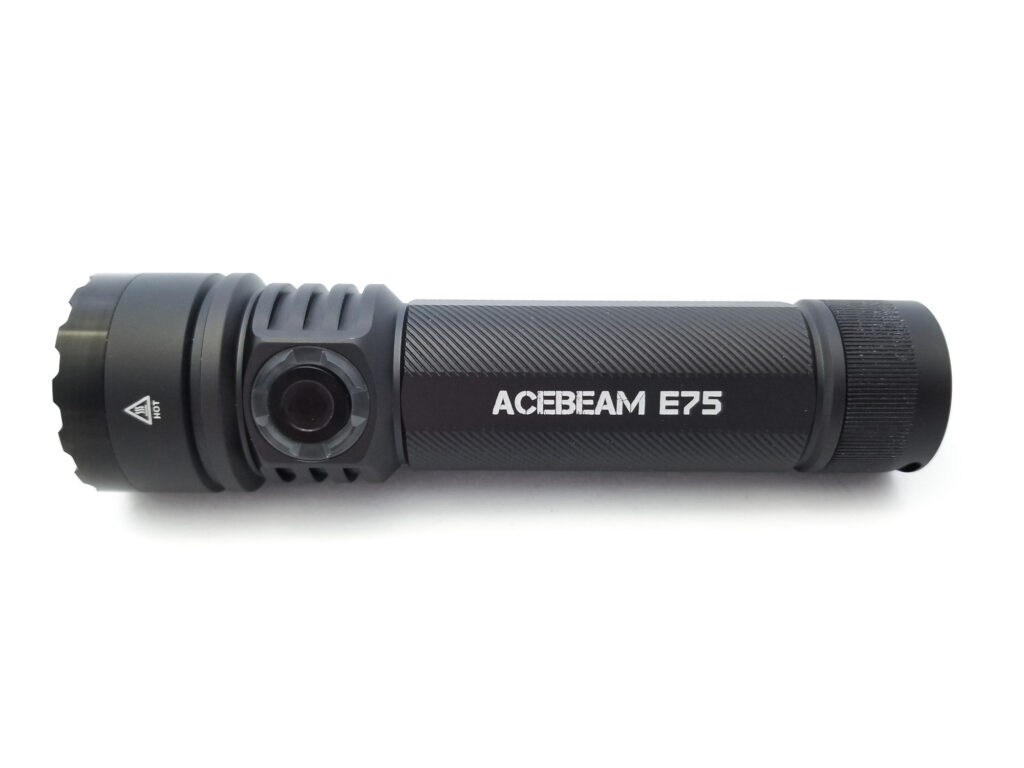
Acebeam E75 specs
| Brand & Model | Acebeam E75 |
|---|---|
| Flashlight category | General Purpose |
| LED | 4*Nichia 519A |
| Max. output | 3,000 Lumens (High CRI) |
| Max. beam distance | 210 m |
| Max. beam intensity | 11,025 cd |
| Battery config. | 1*21700 |
| Onboard charging | USB-C |
| Main modes | 6 |
| Blinkies | Strobe |
| Waterproof | IP68 |
| Review publication date | August 2023 |
Review intro:
Acebeam has no doubt secured their place amongst the premier portable lighting manufacturers, and lights like the one on my desk for review today is the reason why. Everyone and their uncle’s best friend former room mate knows who Acebeam is, but in a nutshell, they’ve been at this flashlight thing since 2014, and have given us some doozies like the X-series, K75, E70, and the L-series throwers to name a few. I’ve reviewed a few, and the consensus? They’re great!
So, on to our review subject today, the E75 which is Acebeam’s latest entry to the EDC/general purpose use continuum. I’m not sure if this is their replacement for the now discontinued EC65 (or the Olight Seeker 3 Pro), but either way, it’s a quad LED, 21700 powered light with 3000-4500 Lumens (depending on the LED, you get two choices). Pretty standard stuff for a high output compact quad. There’s a lot of hype around this flashlight, so let’s see what separates this one from the other quads out there.
Package quality.
Acebeam I think has a bit of a packaging identity issue since my last Acebeams (the Defenders) came in properly nice boxes. The E75 not so much, but it’s a very retailable box with a hang tag and marketing and feature blurbs. Here’s what’s inside:
- Acebeam E75 flashlight
- Acebeam IMR21700NP-500A 21700 battery
- Lanyard
- 2 spare o-rings
- Spare charge port cover
- Manual
- USB type C cable
- Warranty card
- Promotional documentation
- Red traffic wand diffuser (optional)
Once again, this is a super comprehensive kit with everything needed for ready-to-run. Open the box, pull out the light, unscrew the tailcap and remove the isolator, and you’re ready to go. The only thing not optimized is the battery, which was sort of discharged (for storage) to 3.8 volts, so you’ll get nearly the full output, but for max output you need to charge it. As a bonus, Acebeam threw in a red silicone traffic wand. Nice!
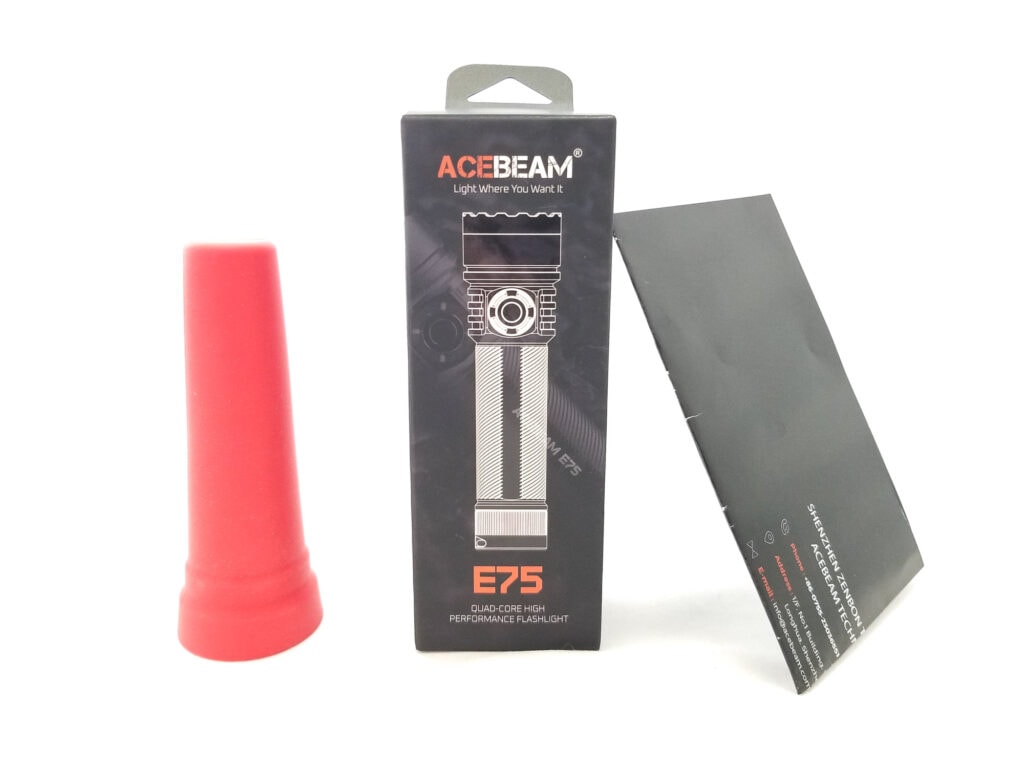
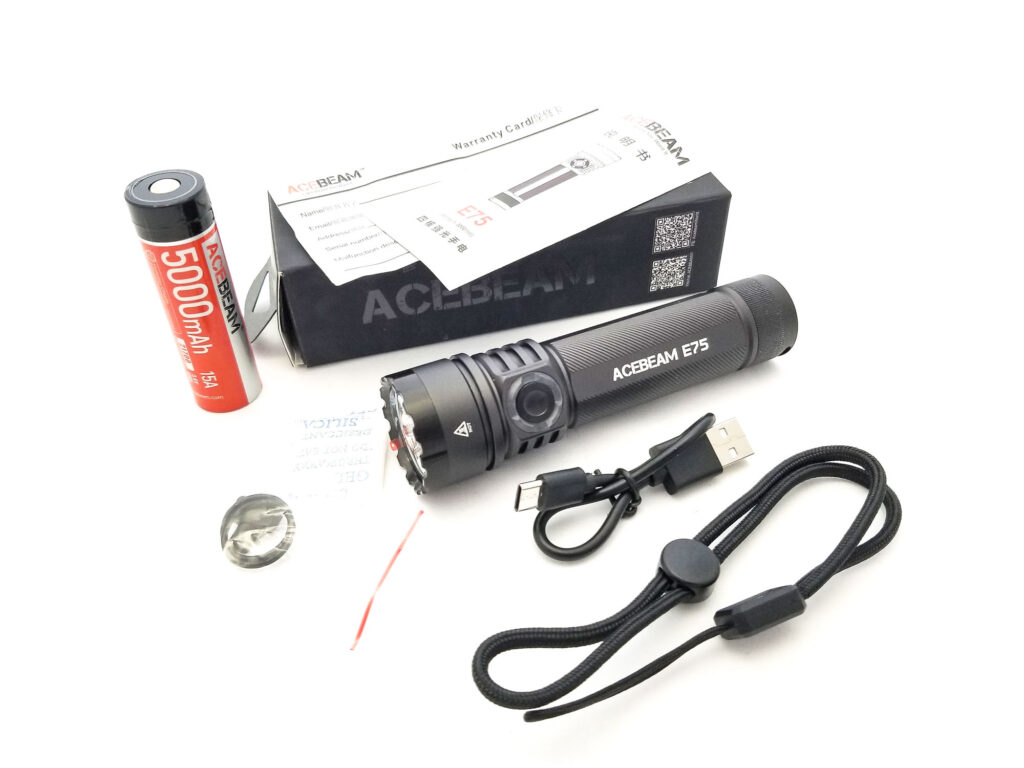
Flashlight in use
The Acebeam E75 is a high output, quad LED general purpose flashlight. It looks similar to the Olight Seeker 3 Pro form factor. You might be thinking, ‘hey, isn’t this an EDC too?’ Well, I tried pocket carrying it, and found the E75 to be a bit too big to comfortably carry. It would ride fine in a cargo pocket or affixed to your pack or belt, which are better options, but if carrying larger lights is your thing, then by all means EDC it.
The E75 has a dual position blackened stainless pocket clip for bezel up or down carry. It’s pretty stiff and while not deep carry, it’s acceptably so. Instead of a friction/interference fit, this one’s secured with two screws. Under those screws, the charge port cover is held on with another screw. Points to Acebeam here for the easy-to-replace charge port cover.
The 21700 size tube is very nice to hold, and the micro striation pattern on the sides adds meaningful grip and it feels nice. It points naturally, and over or underhand use is a pleasure. The tailcap features a stout magnet that can hold the E75 at a 90 degree angle easily. There’s a single e-switch on the head. It sits in a bezel flanked by 4 aux LEDs in a translucent bezel for on state/battery state. It honestly looks a bit odd and maybe a little Pee-Wee Herman’ish and out of place. I’d prefer a more conventional arrangement with a central aux LED or at least a lighted ring.
The switch action is okay, but nothing special with soft clicks and acceptable feedback, but with very short travel that detracts from the feel. The tailcap is wide and flat. Tail standing is a snap, and there’s a lanyard hole with a reasonably sized hole that you can actually thread the lanyard through. The sample light came with the (optional) red silicone traffic wand, and as far as wands go, this is a nice one! It broadcasts pretty pure red light.
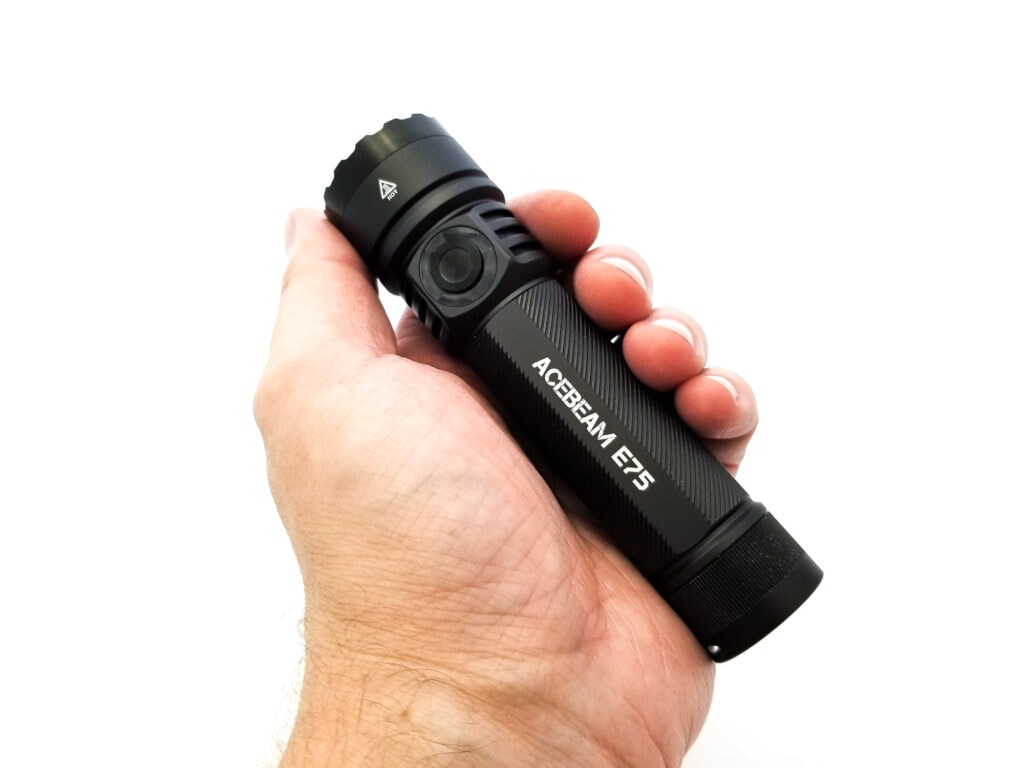
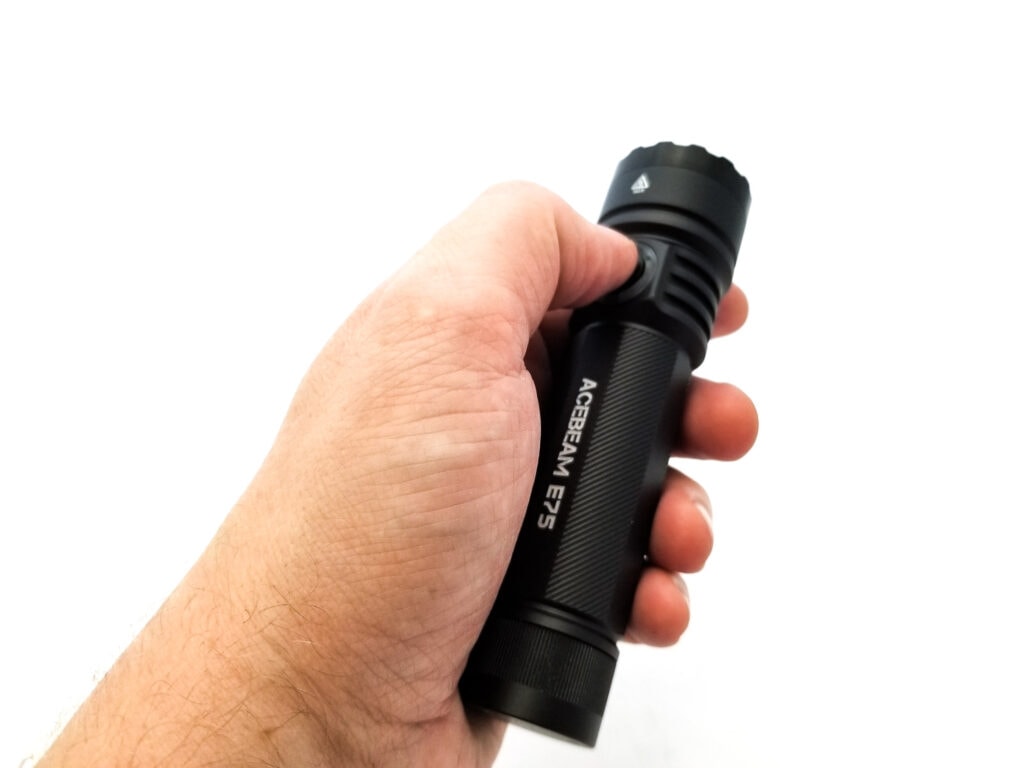
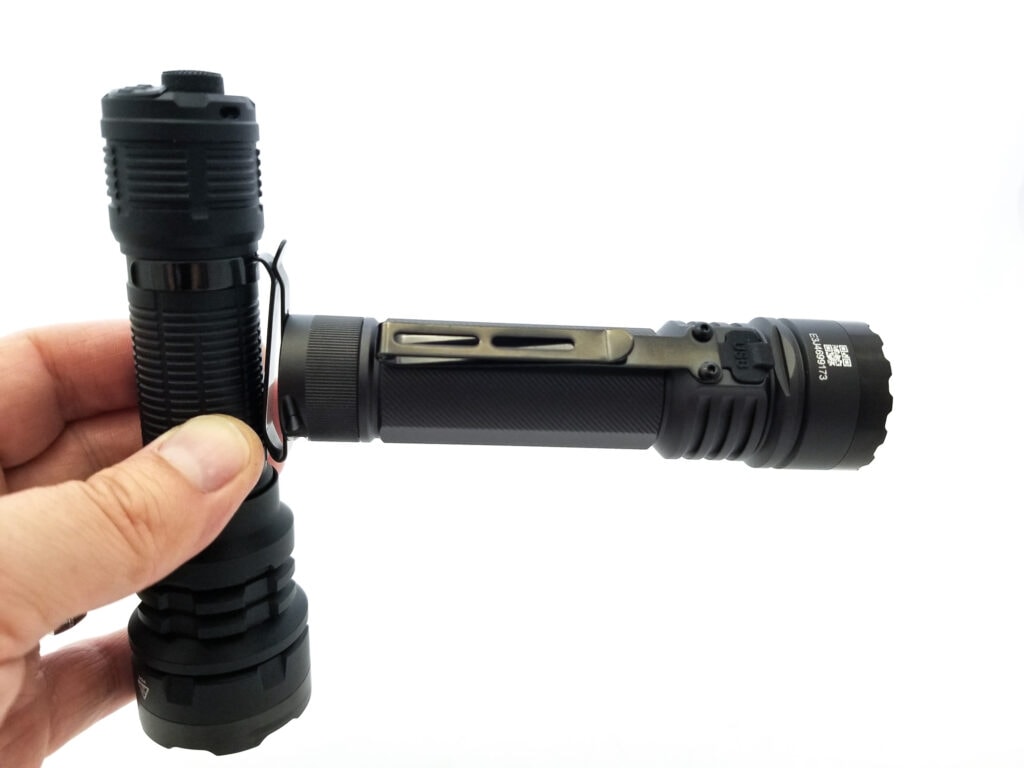
Build Quality and Warranty
Acebeam makes lights of fantastic quality, some of the best. I’ve had zero quality complaints over the years with Acebeam, so that says a lot. The E75 comes in at around $99 US, and that’s with the battery, so it’s a competitive price for something like this. While you can get a quad from Hank, Wuben, Lumintop, Astrolux, Sofirn, etc. for quite a bit cheaper, I think this is a great deal nonetheless for a very high quality light, and one that guarantees great performance.
The E75 is milled from 6061-T6 aluminum, and the machining is super-tidy, and every edge has been knocked down and smoothed. The engraving and silk screen text is super sharp as well, and all the parts fit together perfectly. The magnet in the tailcap isn’t secured well on my sample though, and rattled around during the maracas test. The finish is a matte type III HA anodizing, and it comes in four flavors: Gray, green, black, and teal. My sample came in gray, and combined with the PVD coated black stainless bezel, it’s beautiful. The feel of the finish isn’t like other Acebeams I’ve sampled, but it’s still reasonably grippy.
The light is glued up tight and the only removable part on this light (besides the clip) is the tailcap, which has fully anodized (for mechanical lockout), large, and very precisely machined rectangular threads. They’re very generously lubed and super-duper smooth. The driver and tail feature springs. The tailspring is a captured design, and both springs are thick gold-plated units, and that’s important in a professional-use light since they act like shock absorbers. It’s rated for a proper IP68 water resistance and that’s a spec I trust. There’s o-rings everywhere, and the charge port cover has a thick silicone rubber plug that seals very well.
Warranty? Acebeam take it away! 1. If the customer experiences any problems caused by manufacturing defects in normal use with an Acebeam product within 15 days of purchase, the dealer will replace that product.2. If an Acebeam flashlight fails during normal use and any problem covered under warranty occurs within a period of 5 YEARS (60 months) of purchase, the dealer is responsible for warranty service.
3. Acebeam flashlights enjoy a limited lifetime warranty – after 60 months the dealer will attempt to repair the flashlight for the cost of spare parts and shipping (i.e. no charge for labour).
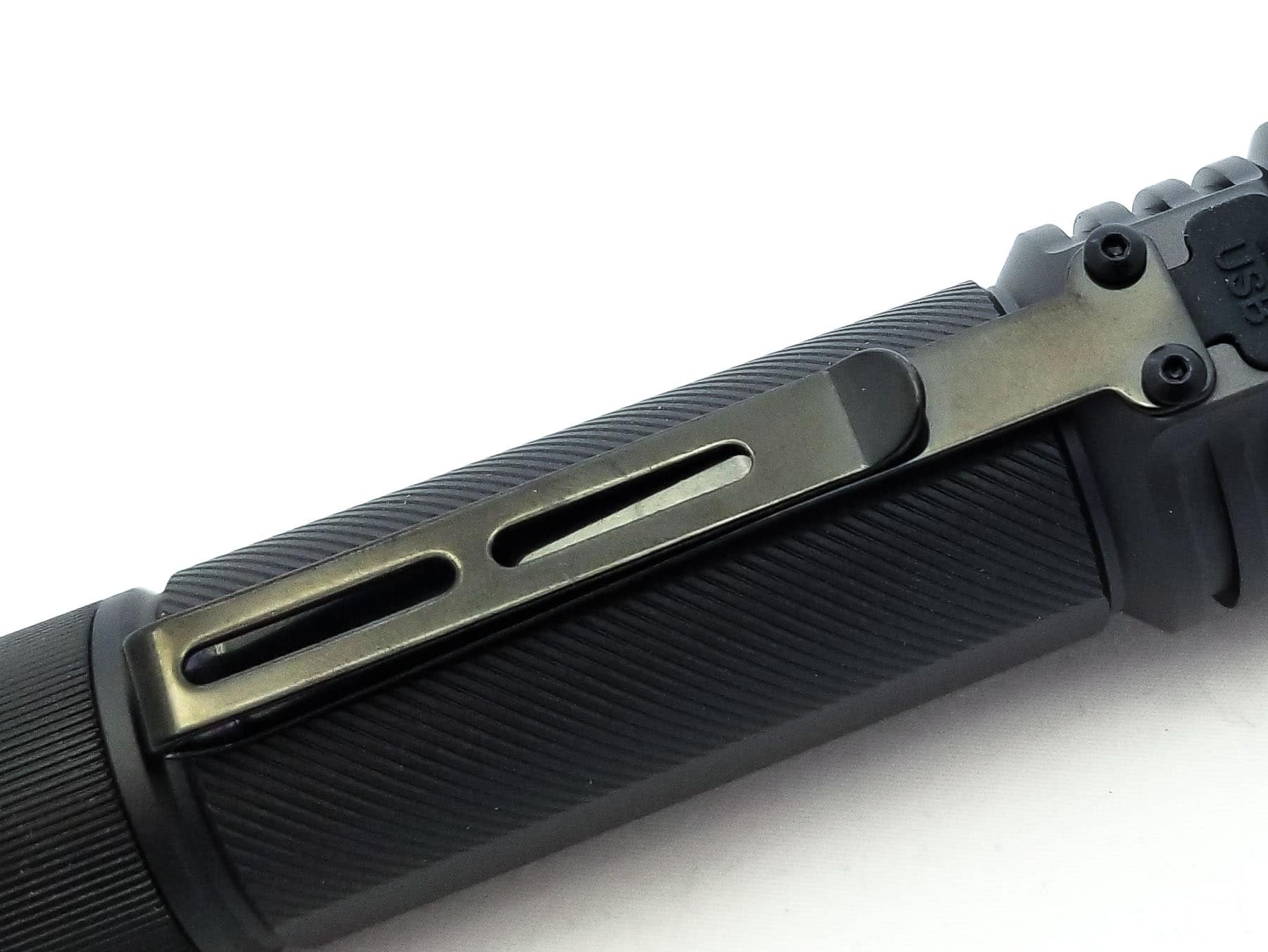
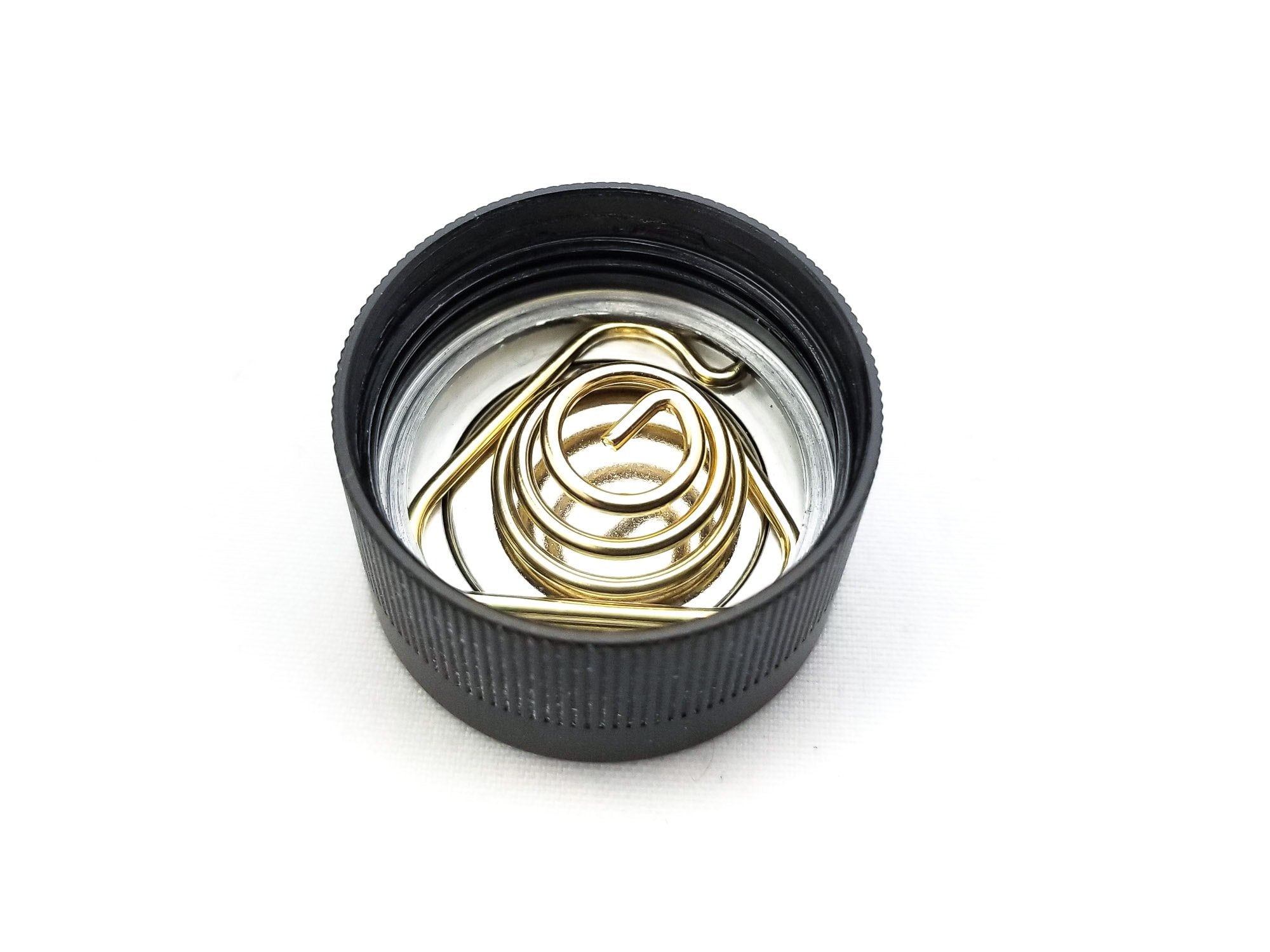
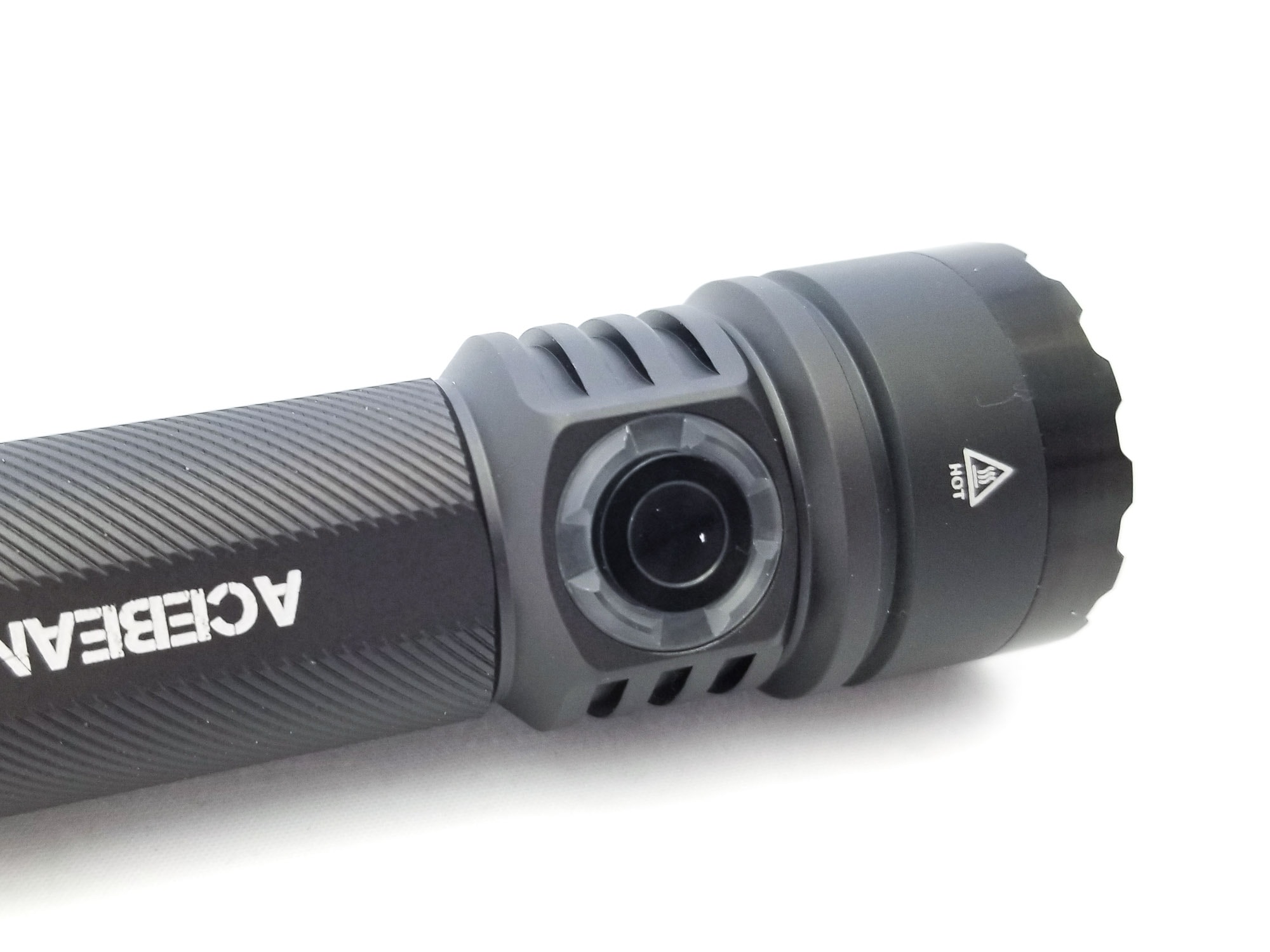
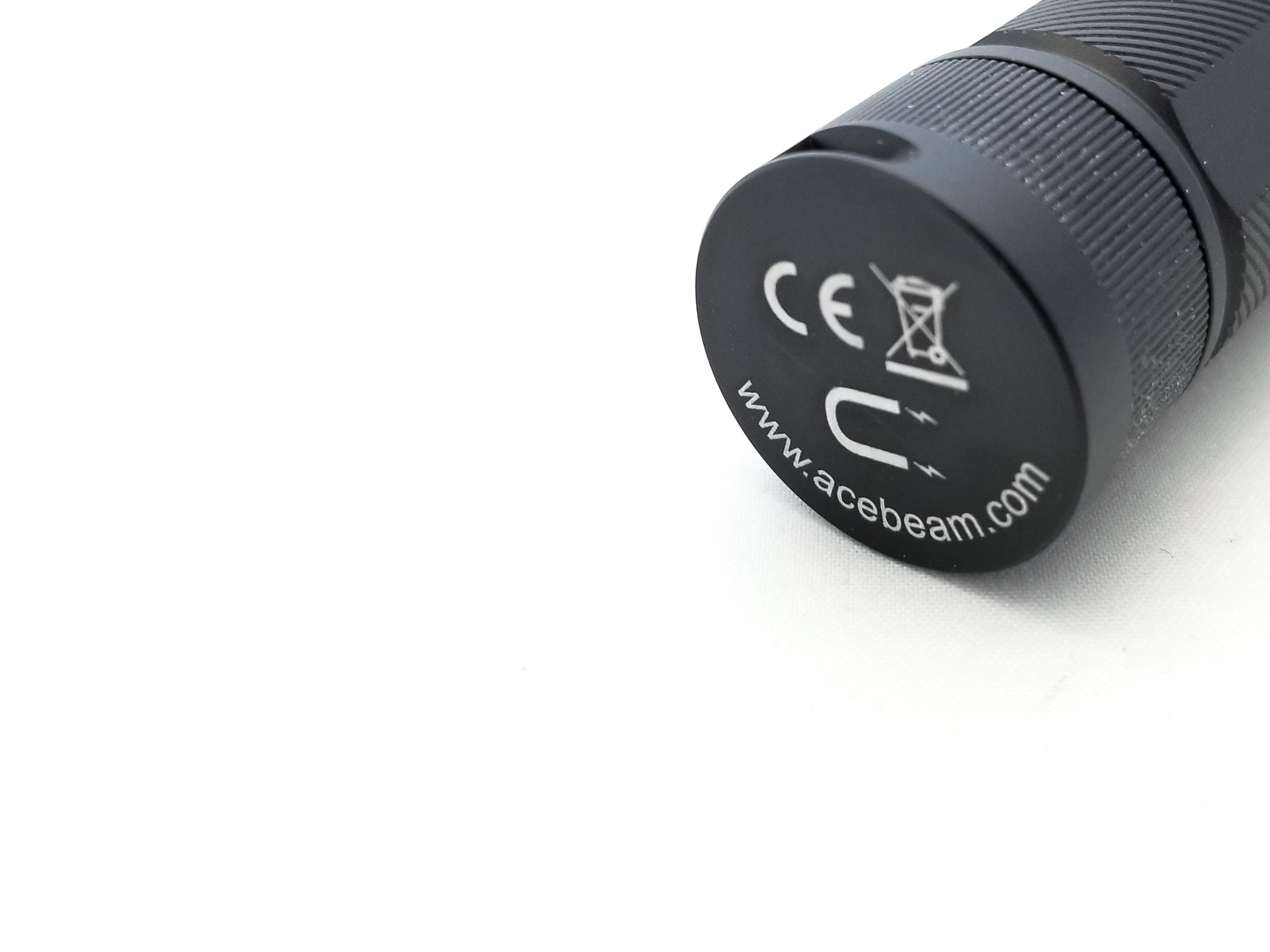
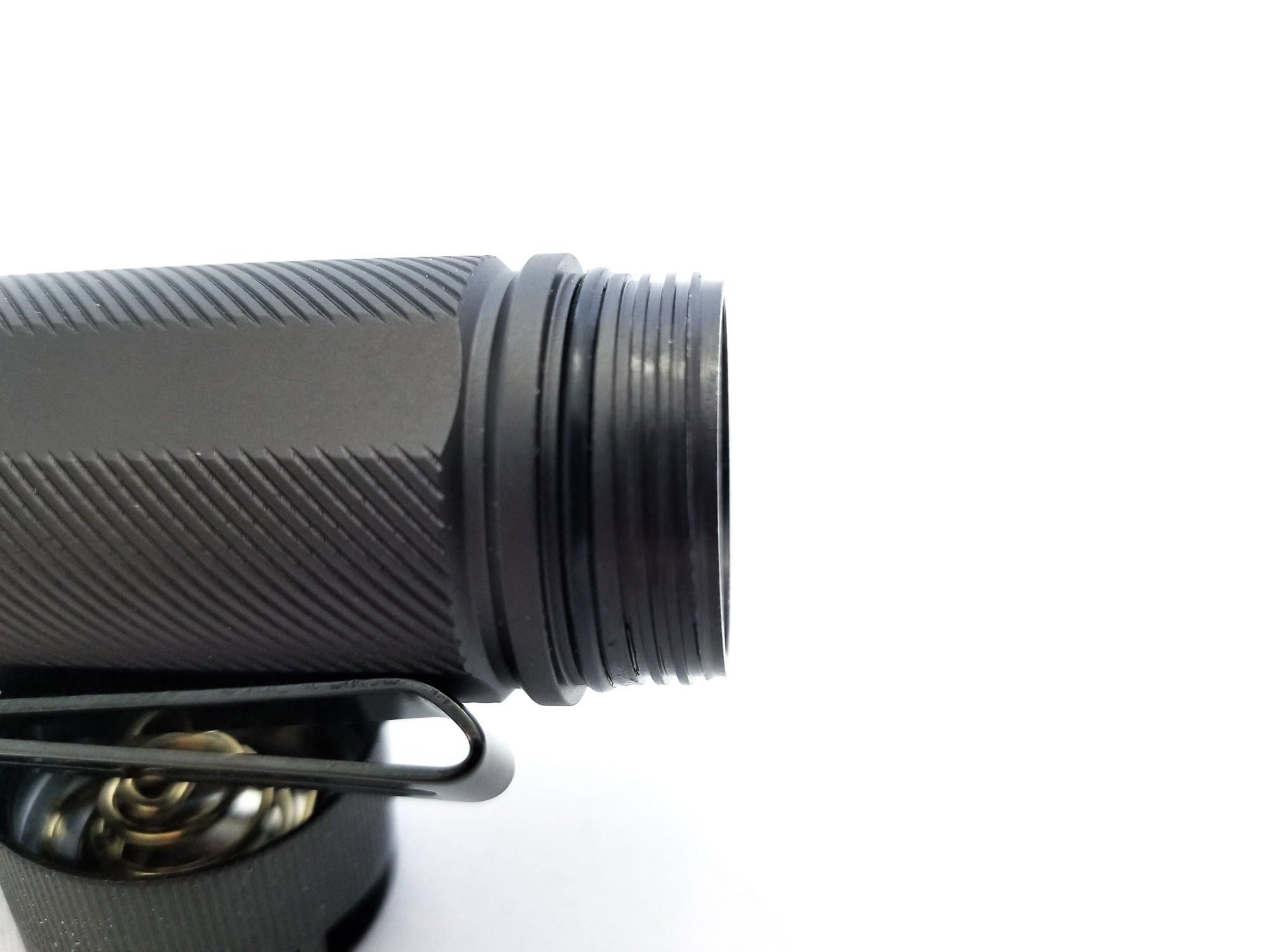
LED, Lens, Bezel, Beam, and Reflector
The E75 adopts a quad reflector/quad LED configuration, a bit of a rarity in the EDC market since most are either single LED or quad/triples using TIR lenses. In keeping with the industry trend, Acebeam conscripted an unknown LED, and Nichia 519A LEDs for the high CRI version. The 519A is becoming the go-to LED, and it’s very versatile with either cooler or warmer CCTs with high CRI available and is a great choice since it has the similar high output of the Samsung LH351D, with less flood (without the green).
You can get the light in either the 6500K (with an LEDs which remain anonymous for the moment) or 5000K 519As, with the 5000K being high CRI. The sample light came with the high CRI LED. The LEDs sit under a quad SMO reflector array topped with an AR coated mineral glass lens. The AR coating has a purple/blue tint to it, and it’s protected by a mildly crenulated stainless steel bezel that’s given a black PVD finish. The beam is about perfect for general purpose use, with a large, easily discernible hotspot and lots of spill. The beam is very clean for a quad, and the tint? The Opple Lightmaster Pro has it coming in at CCT: 4859K and CRI Ra at 96.5 on Turbo 1 meter from the sensor. The duv is -0.0008, trending on the rosy side with excellent color rendering. I like the tint much more than the FA3 and FA4 bins of the SS20.
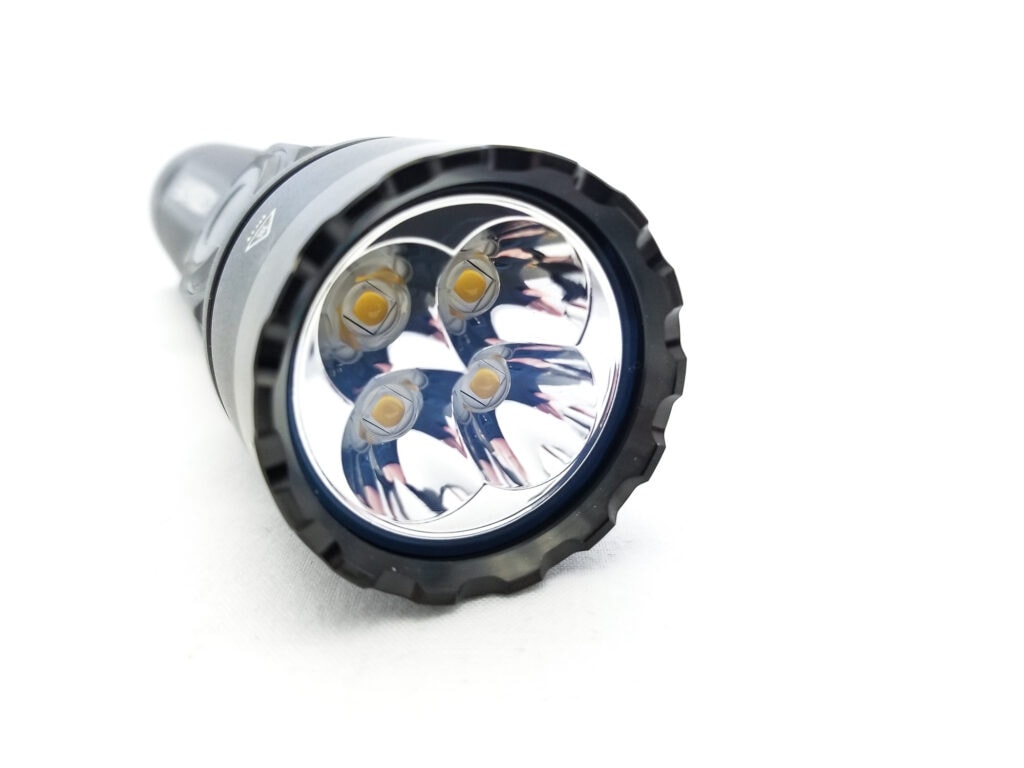
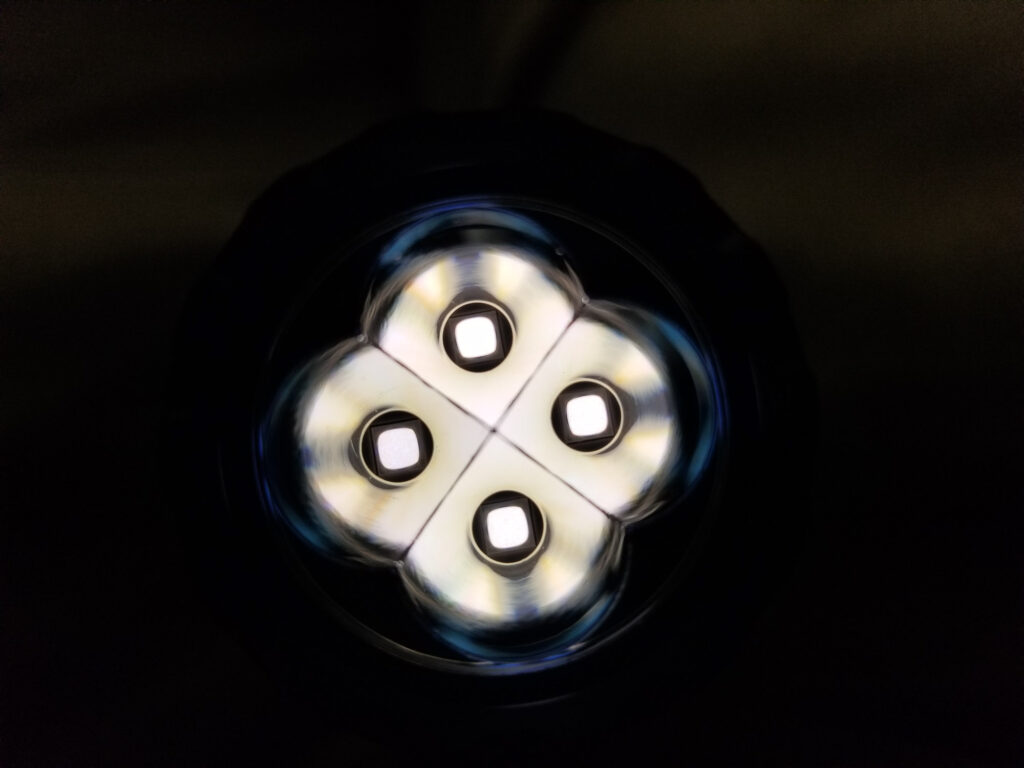
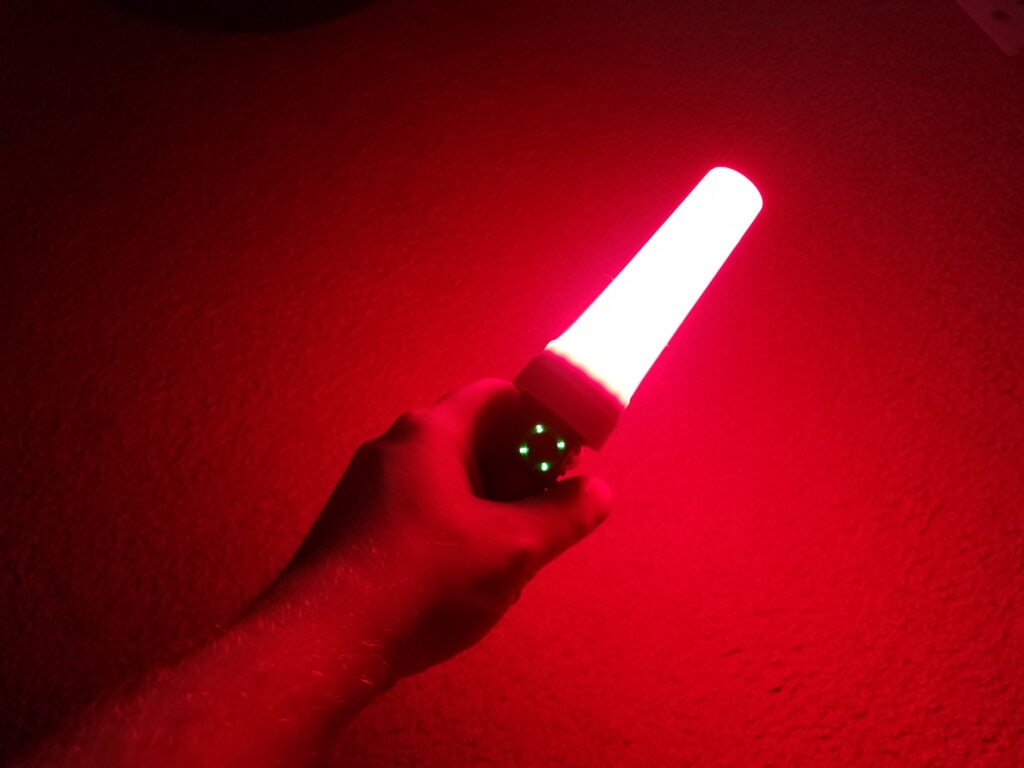
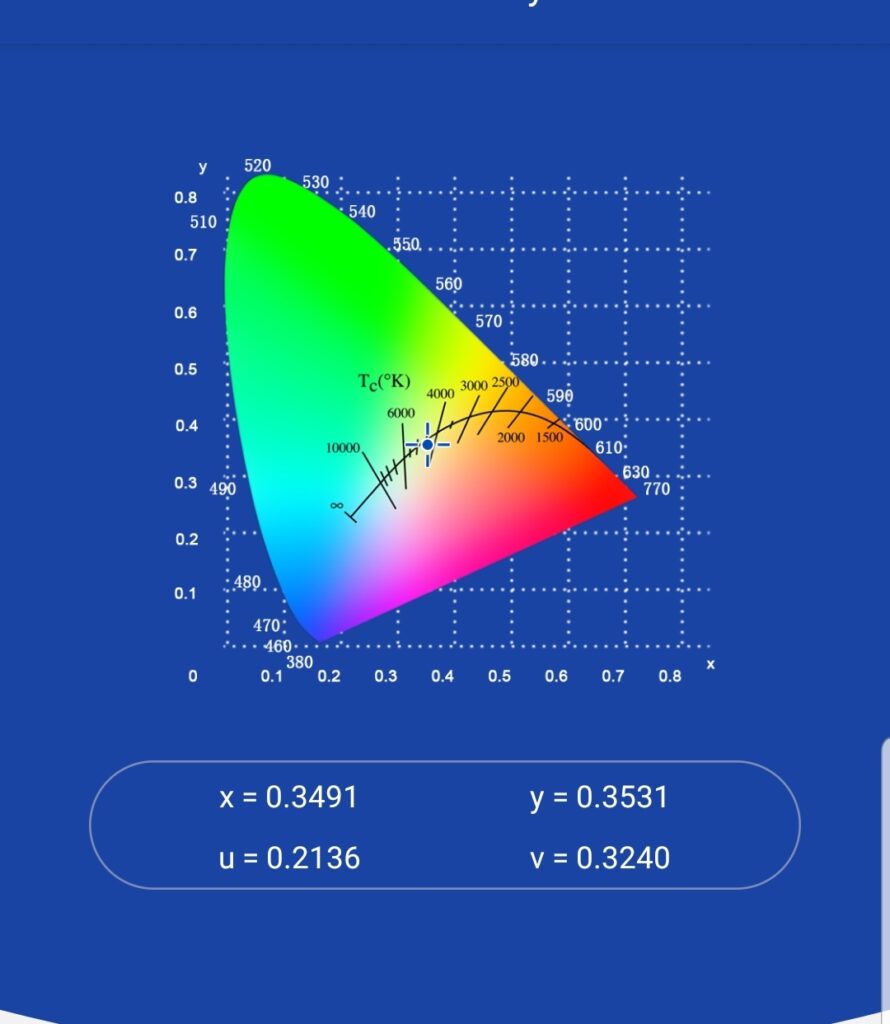
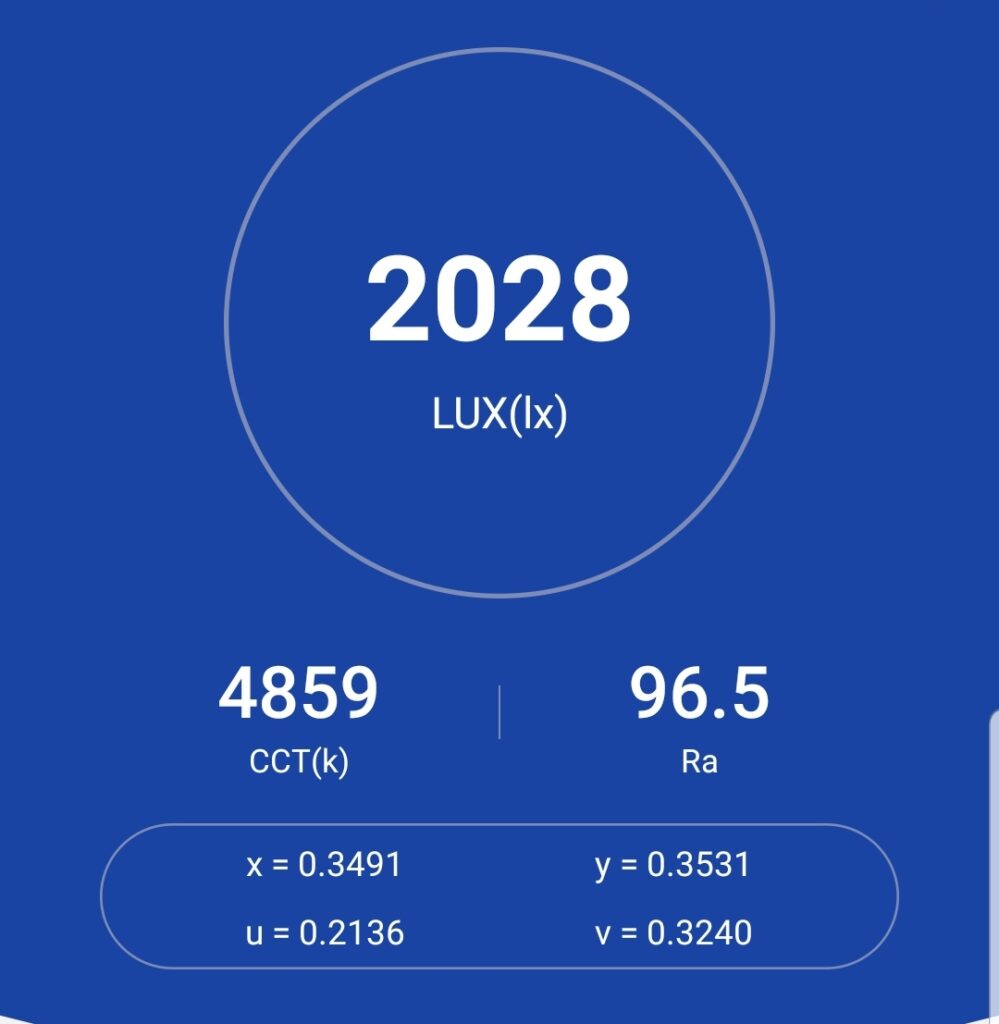
Dimensions and its competition
Dimensions:
| Acebeam E75 | Millimeters | Inches |
|---|---|---|
| Length | 129 mm | 6 in |
| Head diameter | 35 mm | 1.3 in |
| Body | 28 mm | 1 in |
Dimensions are rounded to the nearest millimeter, and to the nearest tenth of an Inch.
Weight:
| Acebeam E75 | Weight in grams | Weight in oz |
|---|---|---|
| With IMR21700NP-500A 21700 battery | 207 g | 7.3 oz |
| Without battery: | 135 g | 4.8 oz |
Weight is rounded to the nearest gram, and to the nearest tenth of an oz.
Flashlight size comparison with its competition:
Group 1 left to right: Thorfire C8, Wurkkos TS25, Acebeam E75, Manker E14 IV with 18650 tube
Group 2 top to bottom: Acebeam P17 Defender, Acebeam E75
Group 3 Reflectors left to right: Manker E14 IV, Acebeam E75, Wurkkos TS25
Group 4 Reflectors left to right: Acebeam E75, Mateminco LT40
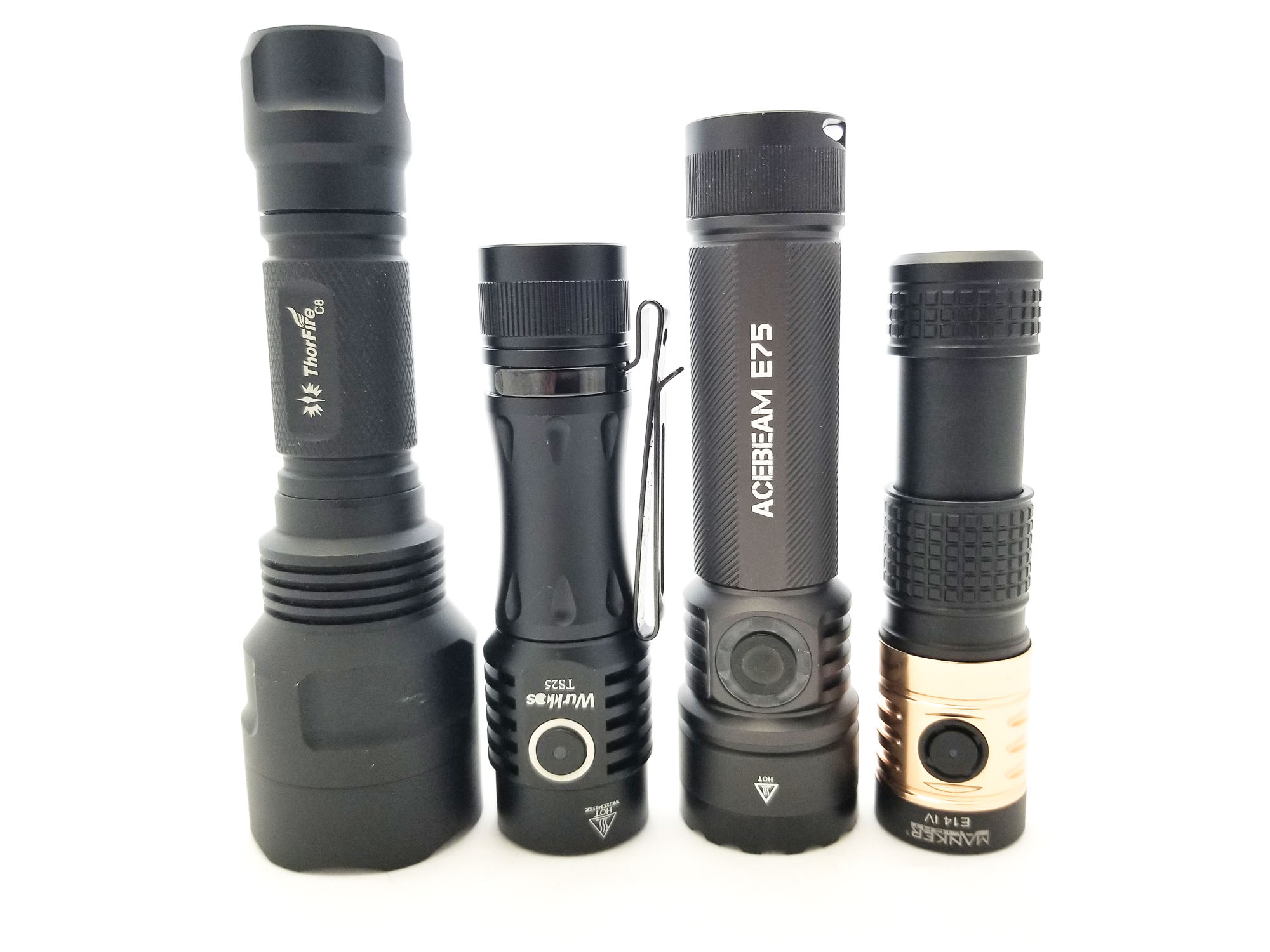
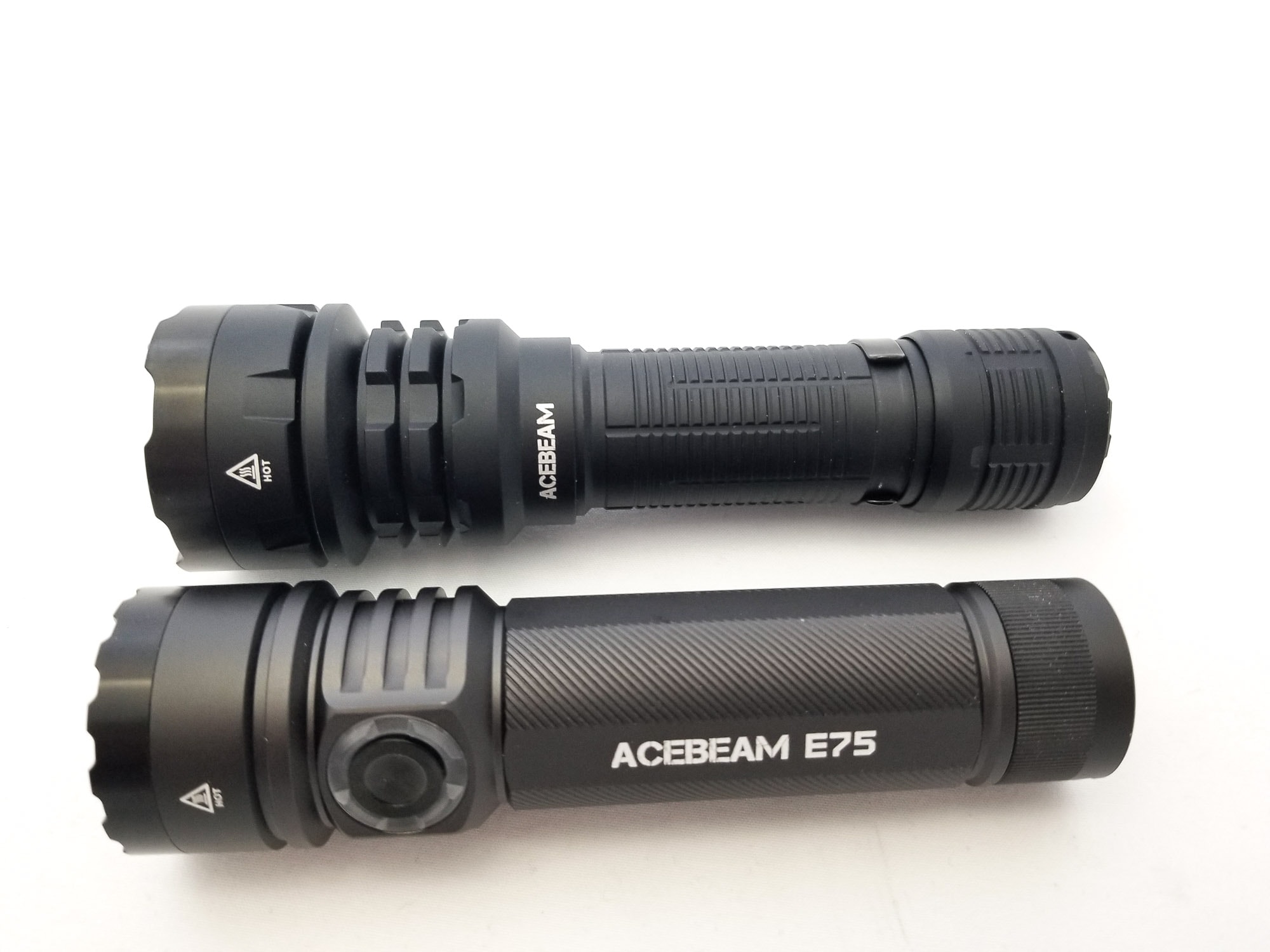
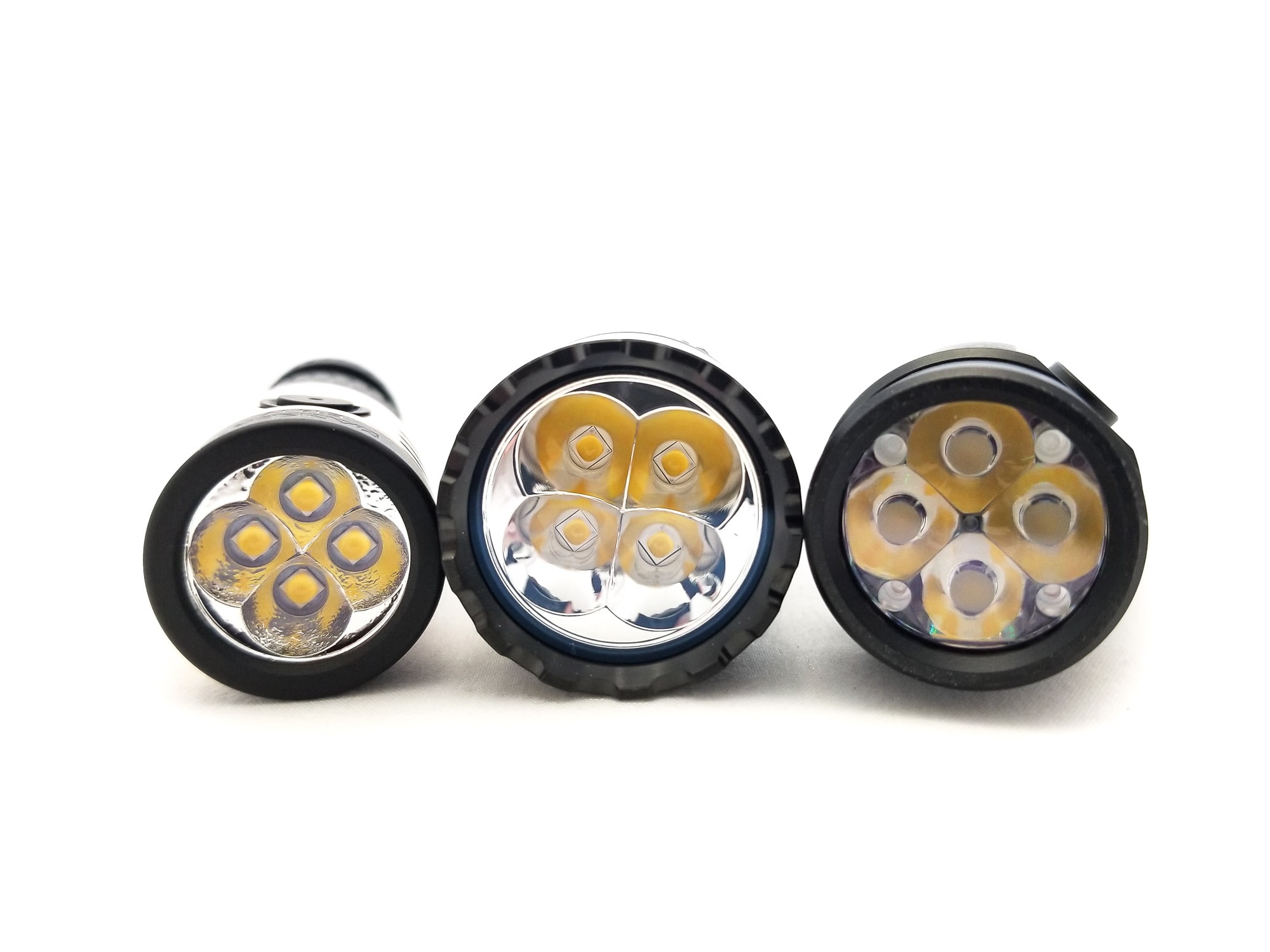
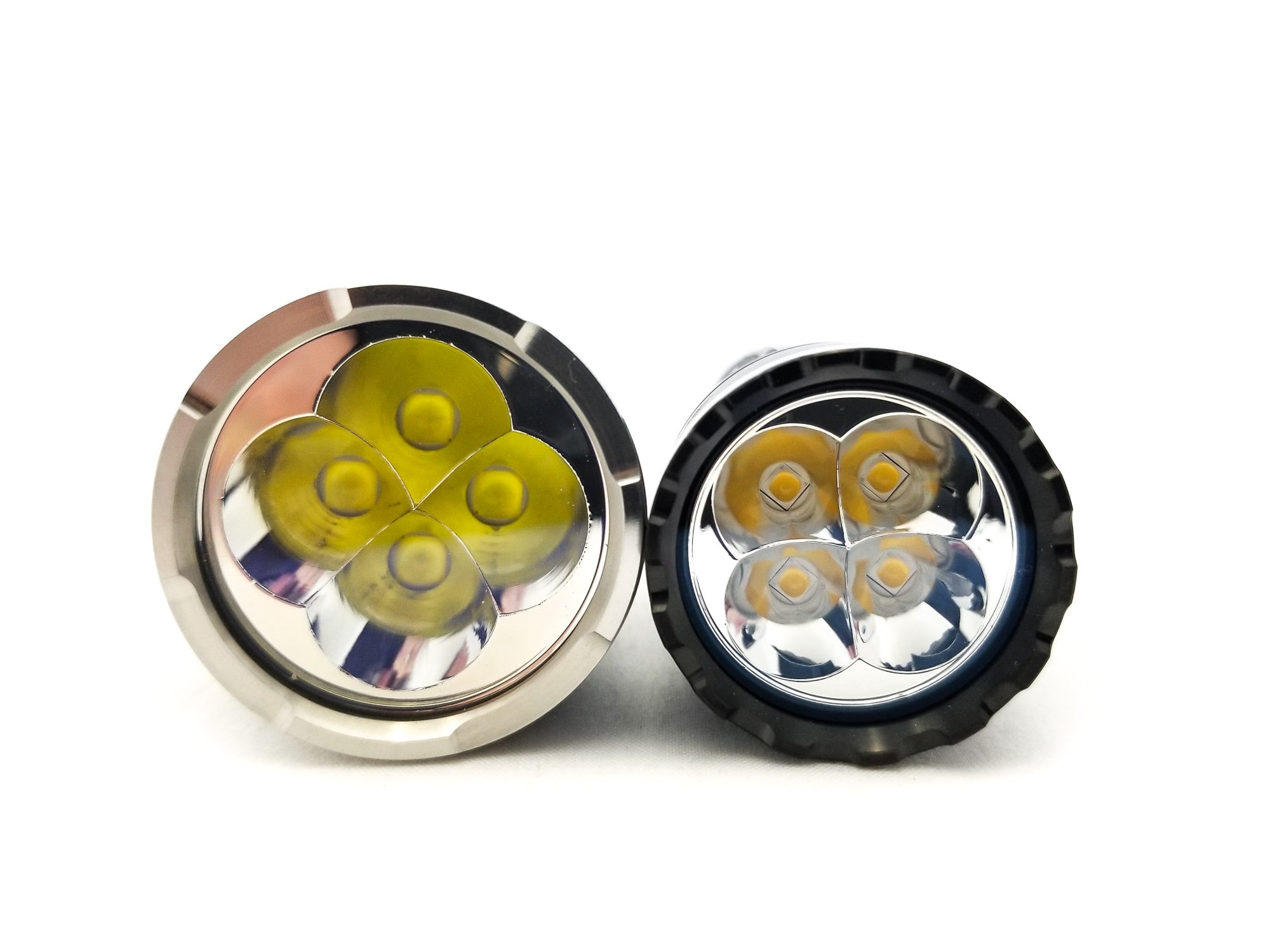
Acebeam E75 UI: User Interface and Driver
The E75 features a constant-current, fully regulated driver for consistent brightness. When I measured the tailcap current, the numbers came in a bit low for a quad, so I’m thinking these LEDs are in series, which requires a boost driver. Acebeam makes some of the best boost and buck drivers around, so it’s going to have excellent regulation. The output is not affected by the battery voltage, so unlike a linear or FET driver, which dims as the battery drains or under battery sag, the output stays constant until LVP kicks in.
UI purists can rejoice here since the UI is straightforward and simple to use with 6 modes plus Strobe. Barring some differences with lockout and special modes owing to that light’s dual switches) you’d be right because it’s almost the same. Ultra Low on the X75 is Moonlight on the E75.
Available Modes:
- Moonlight, Low, Medium 1, Medium 2, High, Turbo
Available blinky modes:
- Strobe
From OFF:
- Single click switch: Turns on in last memorized mode
- Press and hold switch: Moonlight
- Press and hold switch more than 2 seconds: Lockout
- Double-click switch: Turbo
- Triple click switch: Strobe
From ON:
- Click switch: Turns off
- Press and hold switch: Advances through the modes: L-M1-M2-H-L
Mode memory:
- Remembers last brightness level. Turbo and Strobe are not memorized
Shortcuts:
- Triple click: Strobe
- Double click: Turbo
- Double click from Turbo: Strobe
Low voltage warning:
- The LED indicators flanking the switch show the battery state: the charge port cover will show battery state when turned on: Solid green for 20% to 100%, solid red for 10% to 20%, and the LED flashes red for 10% or less (critical battery level).
Strobe/blinkies
- Strobe
Lock-out mode:
- To lockout the light, from OFF, press and hold the switch for more than 2 seconds. The LED indicators will blink. To unlock, repeat and the light unlocks to Moonlight. The light can also be manually locked out.
PWM
- None
Additional/summary info on the UI:
- This is a great UI overall with nothing to really complain about. I’d be nitpicking if I had to point something out, and that would be when double-clicking into Turbo from off. The light goes to High mode for a split second before going into Turbo. Also, I think the Medium 2 mode is a bit unnecessary and really doesn’t add much to the overall usefulness of the flashlight (other than an extra mode). The mode spacing is good as-is, so I’m not too bent out of shape over it. There’s all the necessary accouterments here like LVP and thermal regulation set to 55 C.
Acebeam E75 Charging and batteries
The light utilizes a 21700 size battery and comes with Acebeam’s excellent IMR21700NP-500A 21700 battery. This is a button top 5000 mAh 15 amp rated cell with a protection board. Acebeam’s batteries (like Nitecore and Fenix) are usually sourced from name brands (LG, Samsung), and this one is probably a Samsung 50G or LG M50. It’s a very high quality cell, and it’s non proprietary (ahem, Olight), so you can BYOC (bring your own cell).
The E75 happily digested my Samsung 50G button tops, Acebeam’s USB type C rechargeable 21700, and flat top unprotected cells. The onboard charging is a nice feature in this segment, and set for 5V and 2A over USB type C. I was seeing about 1.89 A and 5 V from a USB type A to C cable, and a type C to type C (yes it works) was similar. A depleted battery was down to 2.98 volts, and fully charged in about 3 hours to 4.18 volts adding a bit under 4800 mAh.
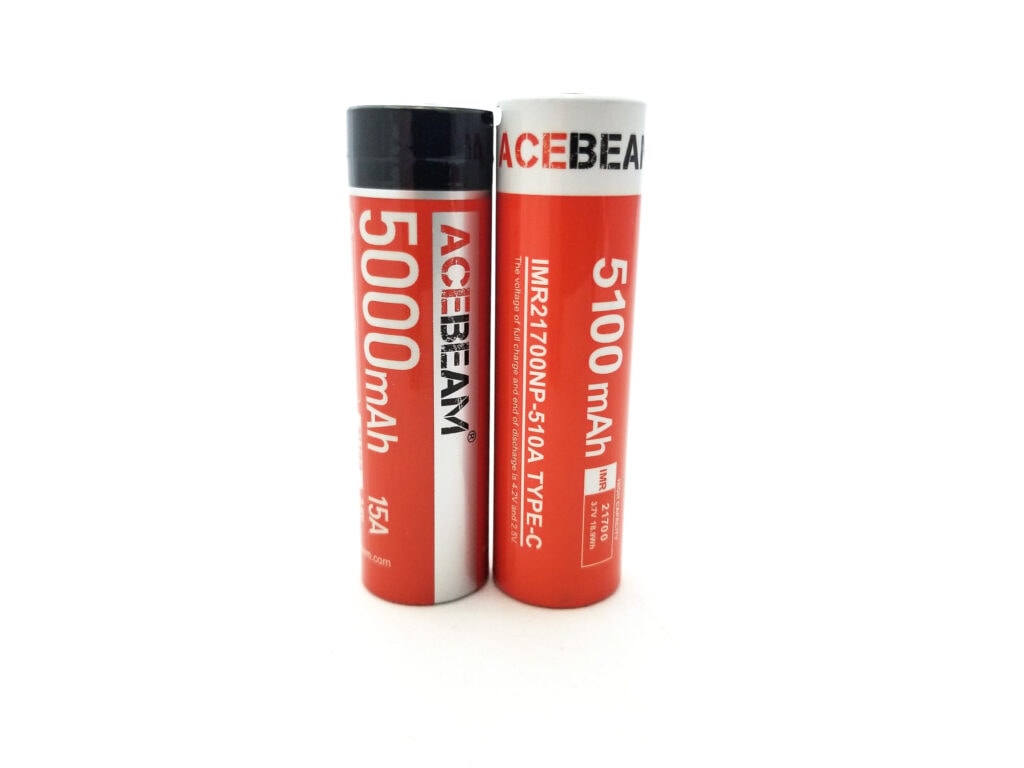
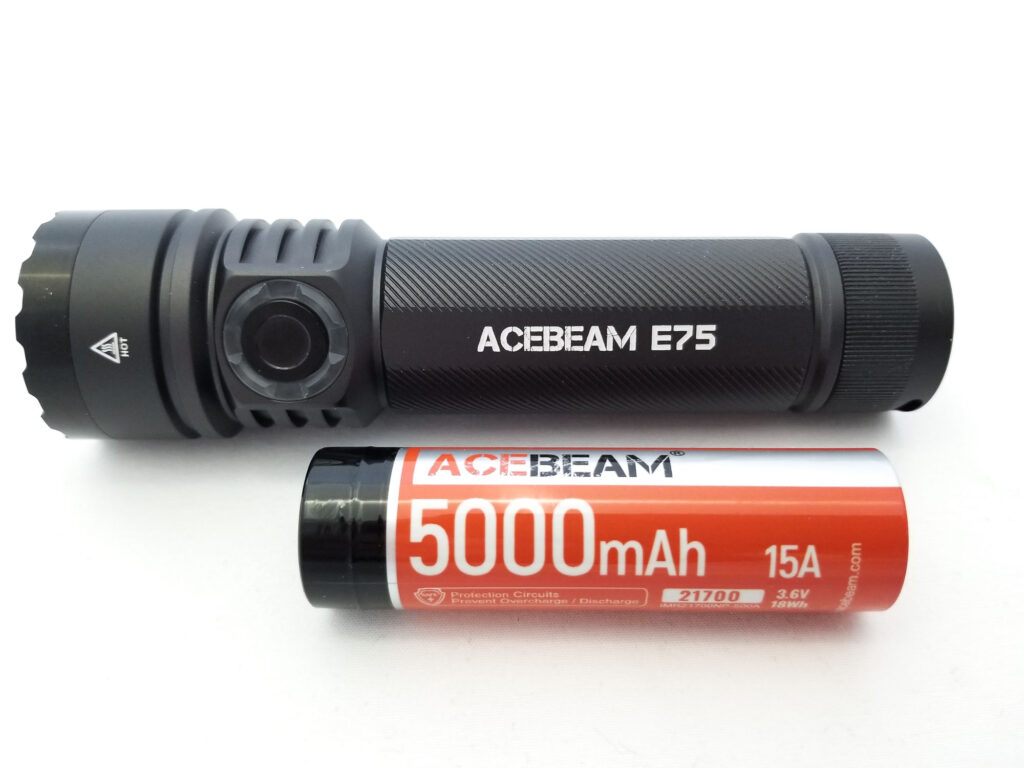
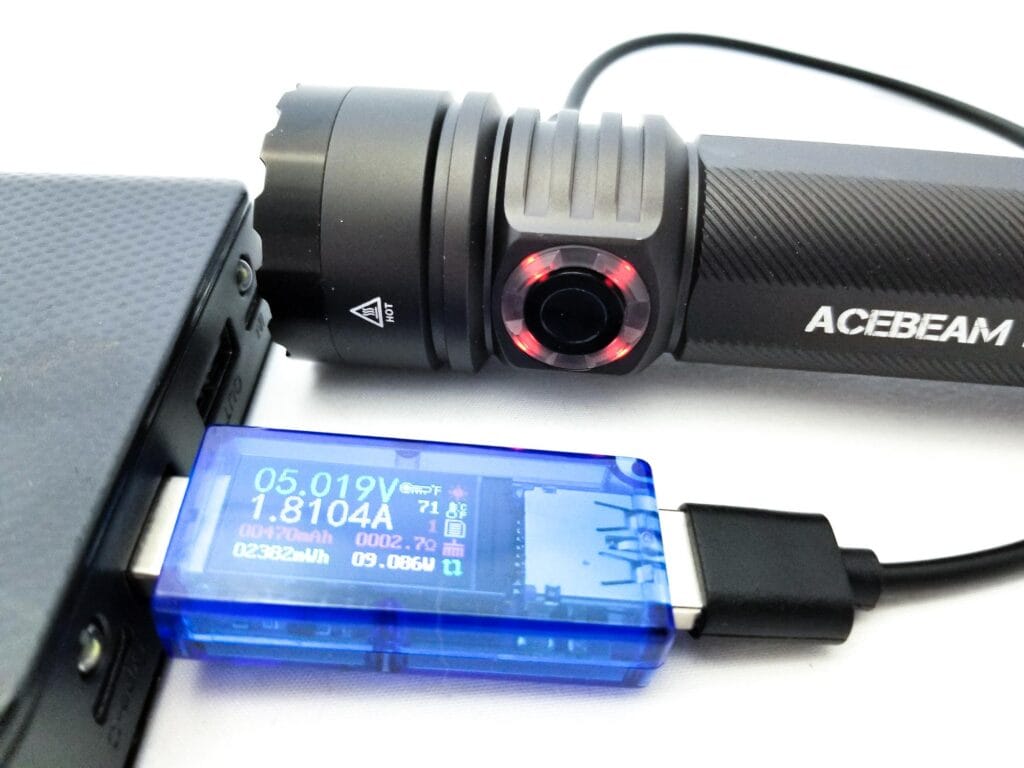
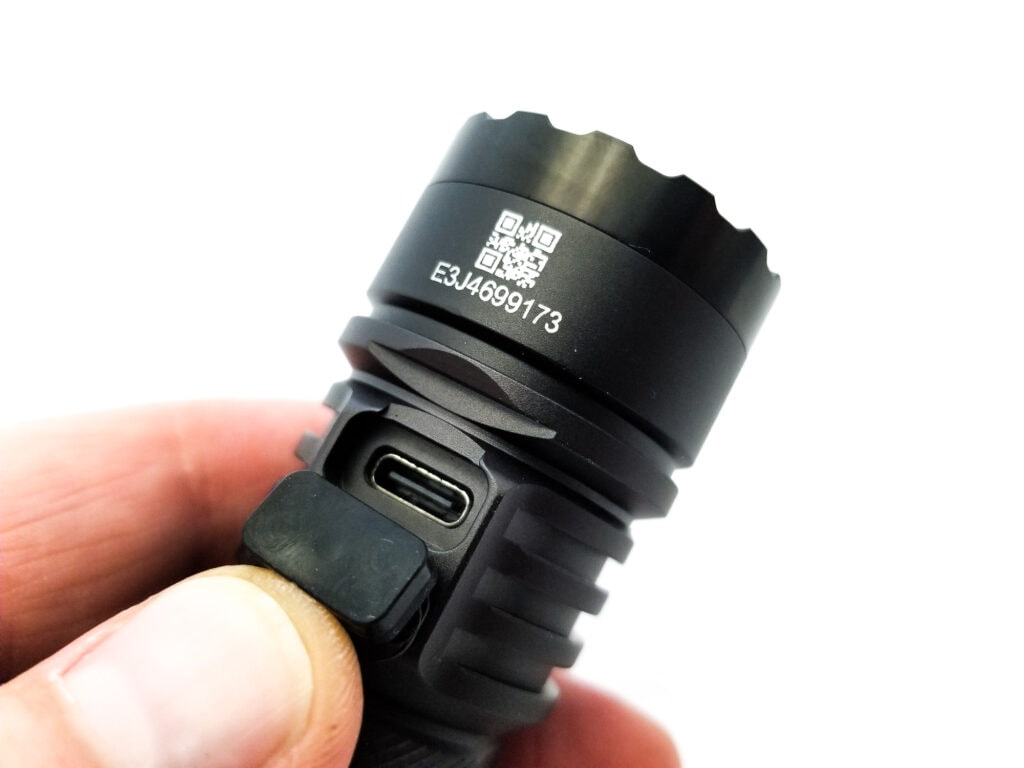
Performance test
Lumen measurements
How Lumens are Measured: Understanding ANSI FL1 Standards How Lumens are Measured: Understanding ANSI FL1 Standards: The ANSI FL1 standards specify that output in lumens should be measured 30 seconds after turning on, as this is the standardized time for measuring brightness according to the industry standard. This is why we focus on this part in our measurements. The ANSI FL1 standards require an ambient temperature of 22 ± 3°C. We record the ambient the ambient temperature to identify potential reasons for any observed discrepancies.Lumens are measured in my 50 and 30 cm integrating spheres (Turbo was tested in the 50 cm sphere) with a Digi-Sense 20250-00 data logging luxmeter. The sphere has been calibrated with a Convoy S2+ measured to 260 Lumens and the figures are within 10% of actual. Current is measured with my Thsinde B18+ digital multimeter with 14 gauge wire on banana plugs in the meter for up to 200 mA, and FY219 clamp meter with a loop of 12 gauge wire for over 200 mA. I used the fully charged Acebeam IMR21700NP-500A 21700 battery for the test.
| Mode | Amps at turn-on | Specs | turn on | 30 sec | 10 minutes |
|---|---|---|---|---|---|
| Moon | 6.7 mA | 1 | 0.8 lm | 0.8 lm | – |
| Low | 57 mA | 30 | 31 lm | 31 lm | – |
| Medium 1 | 311.7 mA | 150 | 150 lm | 150 lm | – |
| Medium 2 | 800 mA | 450 | 415 lm | 415 lm | 406 lm |
| High | 2.2 A | 1000 | 1045 lm | 1037 lm | 979 lm |
| Turbo | 10.4 A | 3000 | 2866 lm | 2767 lm | 947 lm |
Parasitic drain:
- 0.12 mA
The Turbo current is a bit low for a quad LED light, so I’m thinking these LEDs are being run in series behind a boost driver. The Wurkkos TS25 isn’t much brighter and runs at 20+ amps on Turbo.
Acebeam E75 Battery Life: Runtime graphs
How Runtimes are Measured: Understanding ANSI FL1 Standards About ANSI FL1 runtime standards: The runtime is measured until the light drops to 10% of its initial output (30 seconds after turning on). This does not mean that the flashlight is not usable anymore. The last column shows how long the light actually works till it shuts off. If there is a + symbol, it means that the test was stopped at that particular point, but the light was actually still running. This happens on certain occasions, with certain drivers, firmware, or batteries.Runtimes are measured in my 50 cm integrating sphere with a Digi-Sense 20250-00 data logging luxmeter. The sphere has been calibrated with a Convoy S2+ measured to 260 Lumens and the figures are within 10% of actual. I measure temperature readings with my Digi-Sense 20250-92 data logging thermocouple. The thermocouple is affixed to the head with kapton tape, and I used the same 5 second sampling rate as the luxmeter. I used the included Acebeam IMR21700NP-500A 21700 battery for the test.
| Mode | Specified runtime | Measured runtime ANSI | Time till shut off |
|---|---|---|---|
| Medium 2 | 4h 40min | 5h 53min | 7h 33min |
| High | 2h 45min (total) | 3h 18min | 4h 59min |
| Turbo | 2h 41min (total) | 1h 32min | 3h 18min |
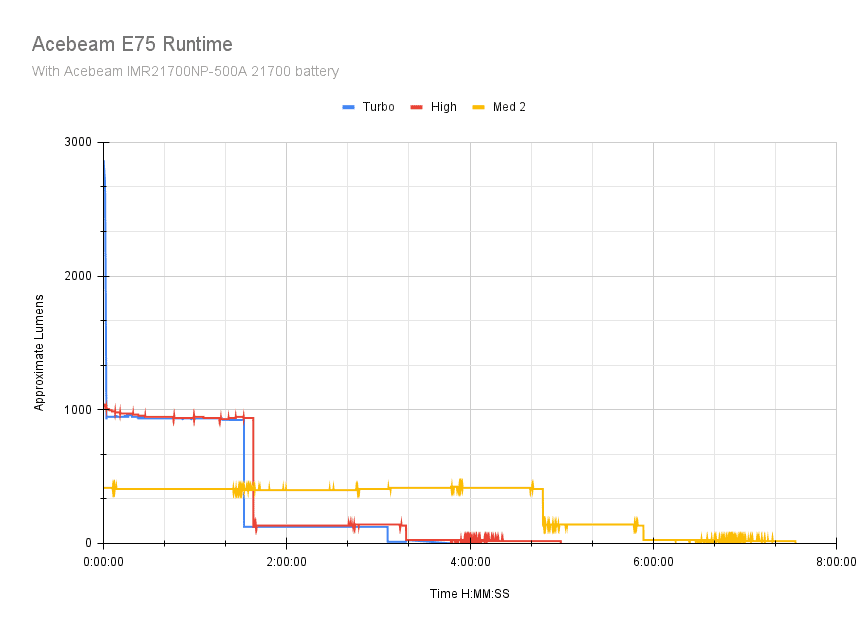
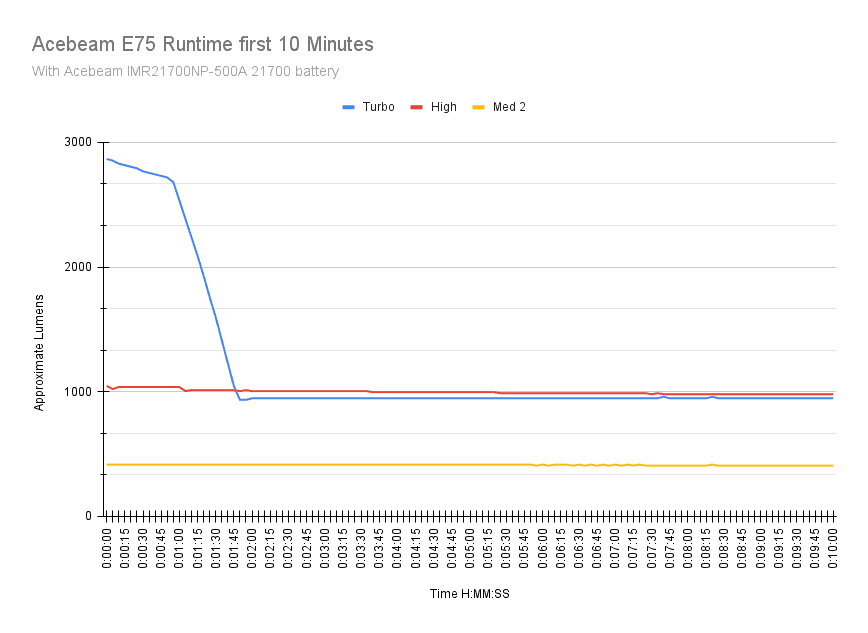
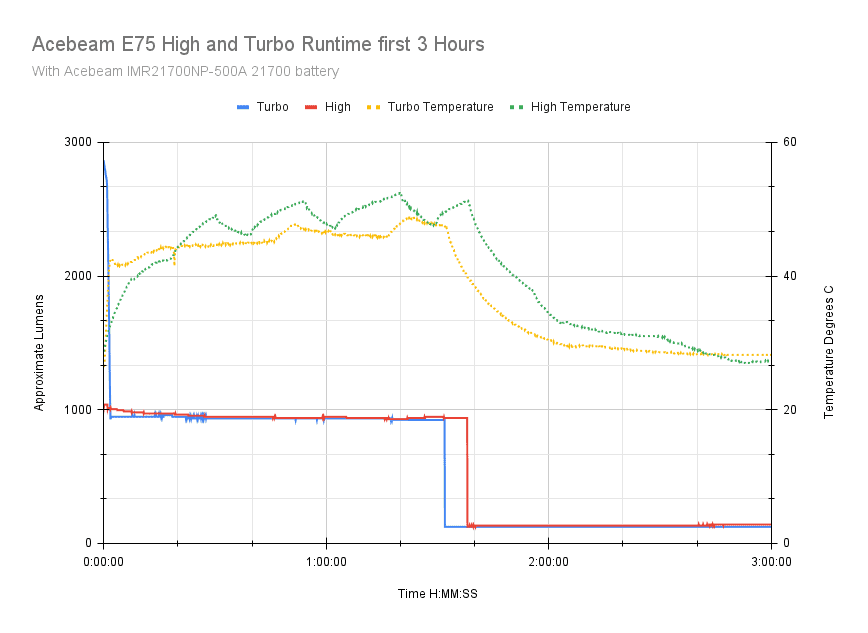
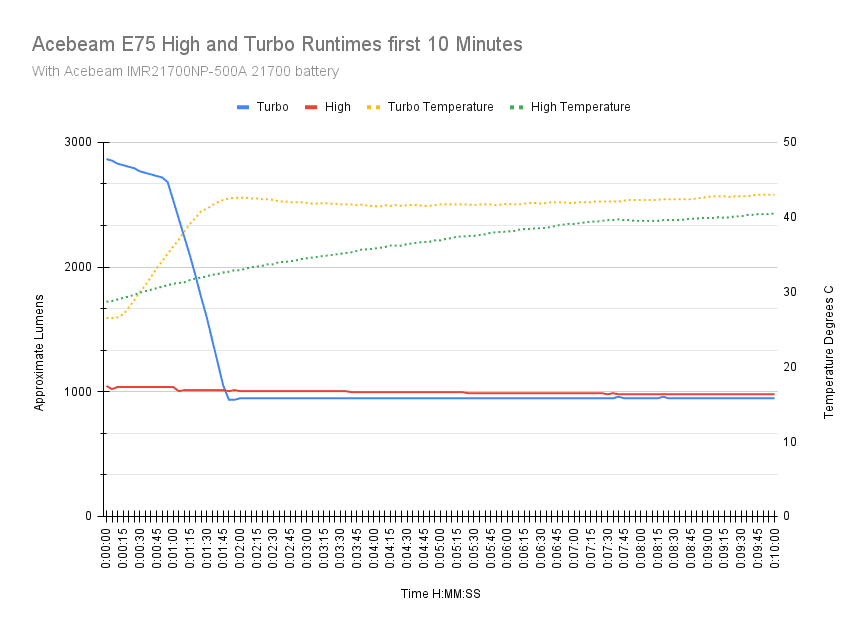
The runtimes look great! The Turbo is coming in a bit under Acebeam’s spec for total runtime, but the others are on point and a bit overboard. For Turbo, the output is almost 1000 Lumens until the step down at 1 hours 32 minutes in. The High runtime tells a similar story. Over 1.5 hours of 1000 Lumen output is pretty amazing. The regulation is amazingly flat and consistent for all the modes which shows we have a boost driver at work here. The temperatures were well managed and temps were pretty tame also, never cresting above 55 C (Turbo seems to have a thermal-limited step down). Even on Turbo, the light was hand-friendly the entire runtime. This would be excellent for using with the traffic wand or for extended use on high output.
I did a comparison of a couple other compact quad LED lights, the Manker E14 IV and Wurkkos TS25. The E75 is by far the superior light here, besting the excellent Manker in sustained output (with the 18650 cell). The FET driven Wurkkos, even with the thermal limit maxed, starts out strong, but falls behind the others.

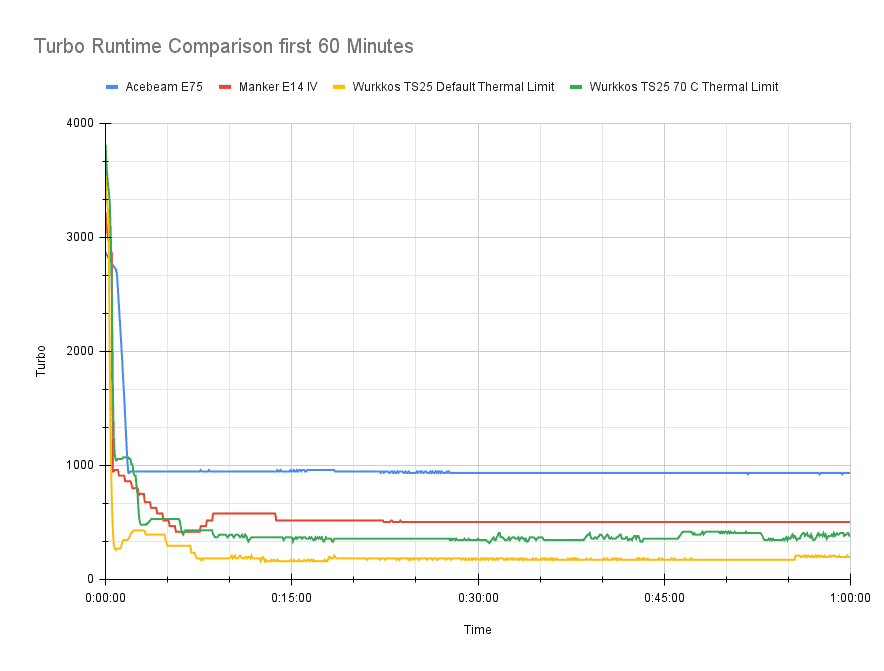
Peak beam intensity and beam distance measurements
About Peak beam intensity: Understanding ANSI FL1 Standards About peak beam intensity The calculated value of distance in meters at which the flashlight produces a light intensity of 0.25 lux. (0.25 lux is about the brightness of a full moon shining on an object). This means that the intensity has decreased so much, it becomes difficult to see darker objects, or objects that don’t reflect light. The columns ‘Meters’ and ‘Yards’ use rounded numbers.The beam distance test was conducted using the Uni-t UT383S luxmeter at a distance of 5 meters. I used the included Acebeam IMR21700NP-500A 21700 battery for the test. Measurements taken at 30 seconds per ANSI spec.
| Mode | Specs | Candela measured | Meters | Yards |
|---|---|---|---|---|
| Moon | – | N/A | N/A | N/A |
| Low | – | 50 cd | 14 | 15 |
| Medium 1 | 841 cd | 500 cd | 45 | 49 |
| Medium 2 | 1618 cd | 1650 cd | 81 | 88 |
| High | 4096 cd | 3950 cd | 126 | 138 |
| Turbo | 11,025 cd | 11,175 cd | 211 | 231 |
The E75 isn’t a thrower, and it isn’t a flooder either, but it does give the best of both worlds I think. There’s more than enough reach out to 150 meters and a bit farther, easily as far as someone can see on a dark night with unaided eyes.
Beamshots
Photos taken with my Samsung Note 8 set to 0.3s ISO 200 and 5000K WB. The fence is 40 meters distant.
Beamshots of the following flashlights compared:
- Acebeam E75
- Wurkkos TS25
- Mateminco LT40
- Emisar D1 v2
- Manker E14 IV
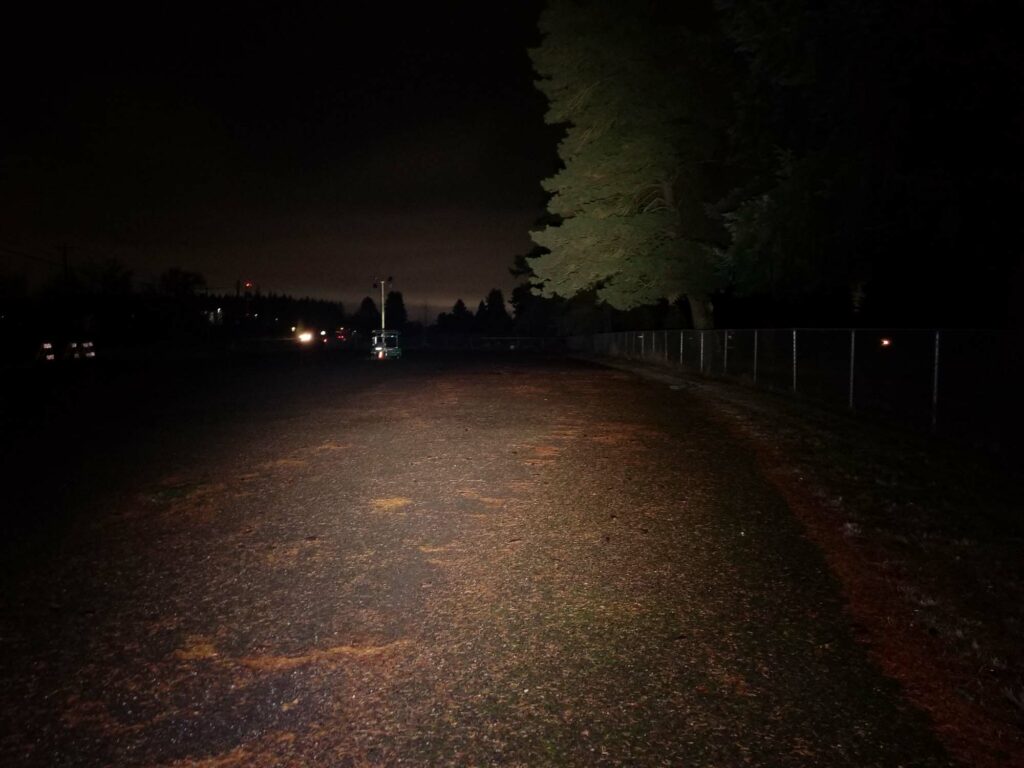
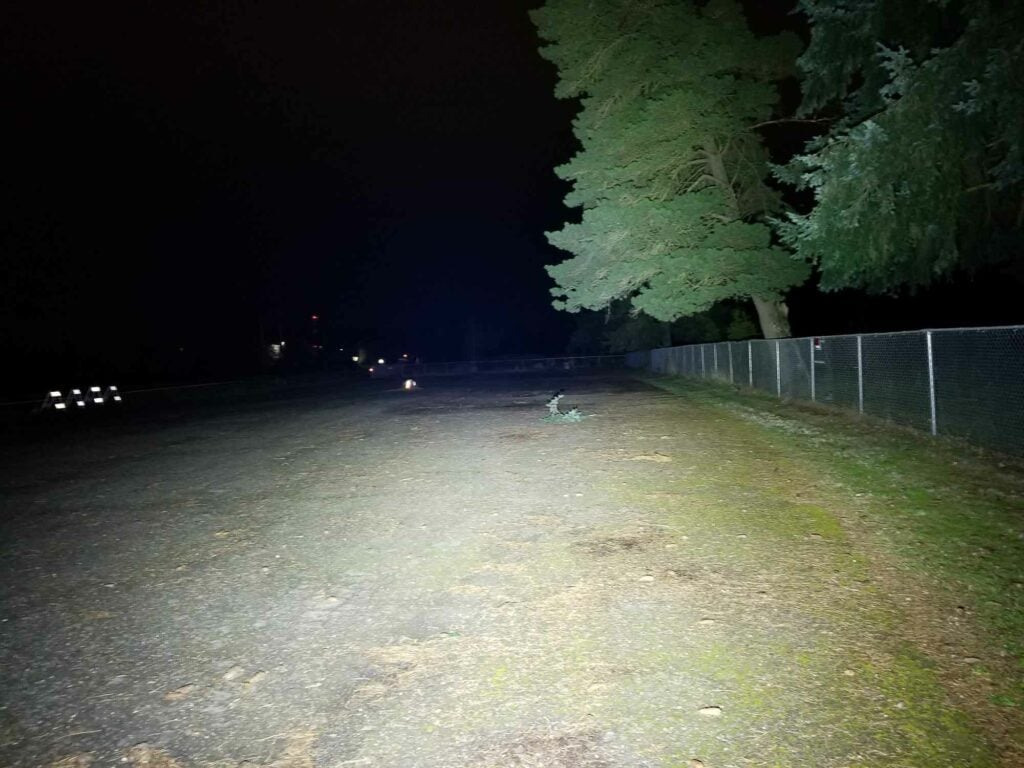

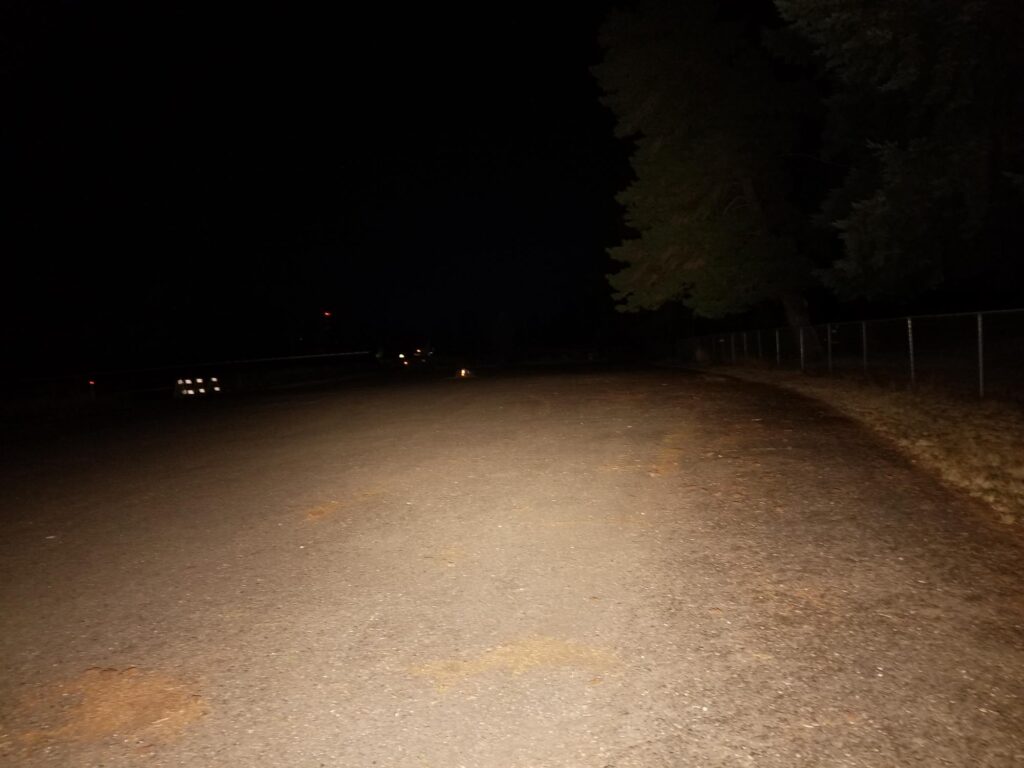
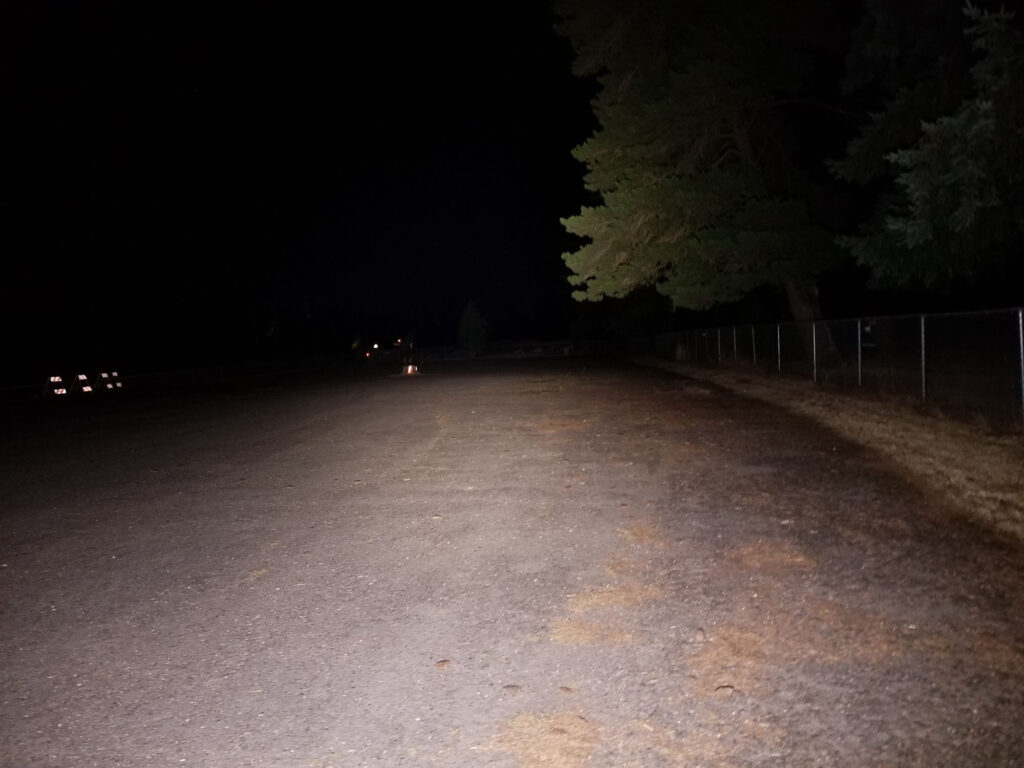
Disclaimer: This flashlight was sent to me for review at no cost by Acebeam. I have not been paid to review, nor have I been holding back on problems or defects.
Final Verdict
Pros
- Awesome build quality, fit and finish
- Onboard charging
- Excellent, fully regulated output
- Handles great
- Non proprietary battery
- High CRI LED option
Cons
- Aux LEDs look a bit odd
- Switch could be improved-feels a bit mushy
Explanation on star ratings:
1: Avoid: a match would be a better choice – 2: Poor: significant defect or issues; almost unusable – 3: Average: some defects or issues; but still usable 4: Good: recommended (minor issues) – 5: Great: highly recommended

5 stars: ★★★★★
While our star rating provides a reliable indicator, we encourage you to read the full review to make an informed decision based on your own needs and preferences.
I haven’t reviewed a flashlight from Acebeam like this, and I’m glad my first one is the E75 because it’s a gem, a rare operator in a pretty stacked market segment. Sure, you can get more compact form factors, higher output, or better beam distance from competitors, but not many can do what the E75 can do. It’s not too hard to sustain 1000 Lumens nowadays, but doing it in this form factor is pretty special. Acebeam did it in a semi-compact single-21700 host.
The handling is great, and the special knurling is effective and aesthetically pleasing. As always the fit and finish are characteristically Acebeam (excellent), and it takes standard 21700s, and the electronics are excellent (as usual). I like that Acebeam gives the buyer a choice of either standard CW or high CRI NW LEDs (none other than the 519A). I like the attention to detail as well, with the charge port cover held on with a screw. There’s not much that I could find to nit-pick with the E75, but I didn’t really care for the indicator LED arrangement. It looks a bit out of place here.
The brief stop at High when clicking to Turbo was odd also, but again, none of those are a deal-breaker. I think Acebeam hit it out of the park with the E75. The only real competitor is the Olight Seeker 3 Pro, which has proprietary charging and you’re stuck with the Olight batteries. While I wouldn’t call this a pure EDC rig, you could EDC it, but I think this is a fantastic general purpose flashlight. It would be at home on a utility belt, tool bag, or emergency kit. Take it hiking, camping, or on a walk, under the sink, or under your car. Shelf queen it or bang it around.
The E75 is going to be gracing my end table for a long, long time as my go-to utility light. Yah, it’s that good! Just get one. 5 stars for the E75.
Buy your Acebeam E75 with a discount
Get a whopping 15% off your next order at Acebeam.com with the following discount coupon: AE15. Simply add the coupon code at your checkout.
1lumen selects and reviews products personally. We may earn affiliate commissions through our links, which help support our testing.